VVAM Airborne Magazine no.10/11
CONTENTS
3.Restarting the Society of Friends of the Airborne Museum
6. Interview Ben Kolster
7. Altered arrangements for entrance to the Airborne Museum
8. Helmet of SS-Brigadeführer and Generalmajor Heinz Harmel
9. British Empire Medal for Hiltje van Eck
10. Mixed feelings for the demolition of Hotel Dreijeroord
11. 82nd US Airborne Division at Nijmegen
22. SS-paraphernalia in a museum: dilemma?
25. Ministory nummer 126: Memories of an eight year-old of the Battle of Arnhem
30. Book review: The Lost Company
31. Ministory nummer 127: Location discovered of two famous ‘Arnhem’ photos
34. Villa Hartenstein to be restored to its original condition
35. Programme 2018
Cover: Hotel Dreijeroord in September 2017.
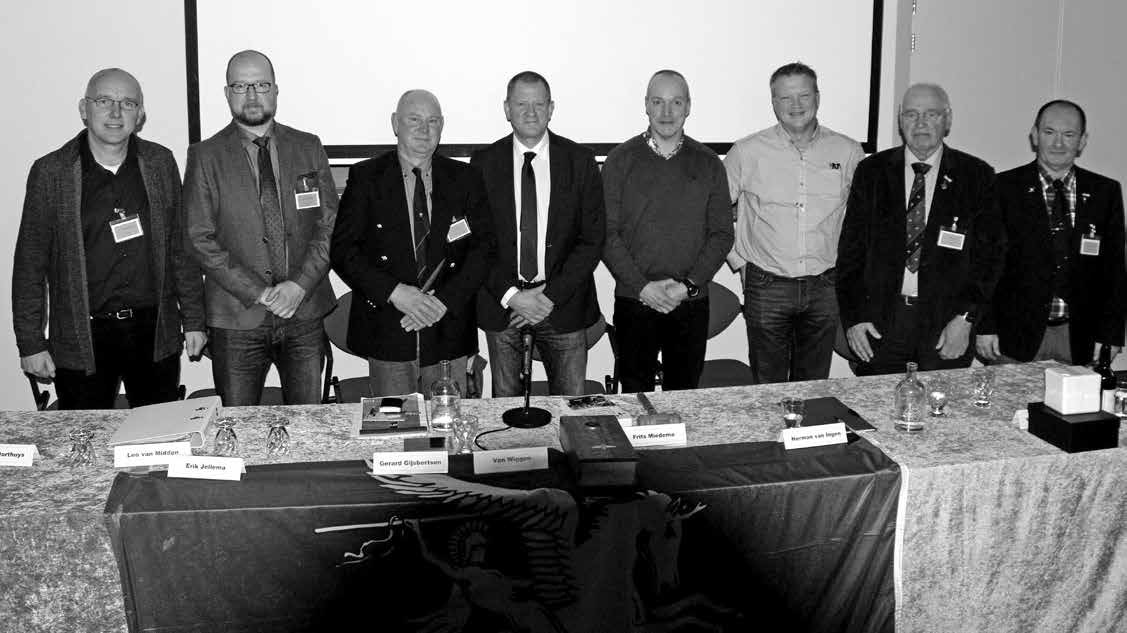
The new board of the SFAM, left to right: Leo van Midden, Jasper Oorthuys, Erik Jellema, Otto van Wiggen, Herman van Ingen, Bernhard Deeterink, Wybo Boersma en Gerard Gijsbertsen. (Photo: Willem Kleijn)
RESTARTING THE SOCIETY OF FRIENDS OF THE AIRBORNE MUSEUM
During the general meeting on the 2nd of December, I was privileged to accept the presidency of the Society. From now on I’m responsible for a brandnew board together with Erik Jellema (Activities and Events), Leo van Midden (Website), Jasper Oorthuys (Airborne Magazine), Herman van Ingen (treasurer), Bernhard Deeterink (membership administrator) and Gerard Gijsbertsen (secretary). This new board will be counselled by general advisor Wybo Boersma. The Society no longer depends on the outgoing board chaired by acting chairman Gerard Gijsbertsen, a situation which arose after the sudden passing of designated president Alex Koning on the 10th of January 2017. In this column I would like to express my gratitude to the members of the discharged board Eric Paap (treasurer), Frits Miedema (membership secretary) and Will Rieken (minute taker) for their contributions and involvement in support of the Society. Second, I would like to thank Okko Luursema and Paul Tirion for their efforts as part of the ‘commission of wise men’ assisting the outgoing board in creating a new board.
With the appointment of a new board, the Society can now follow through on the restart of its activities. This restart has become necessary due to the differences of opinion that have originated between the Society and the Airborne Museum. These differences were caused by a written appeal by the chairman of the Airborne Museum Foundation to put more effort into transforming the Society into a fundraising partner for the Foundation. According to the chairman “the activities of the Society were too dissociated from the Airborne Museum” and “the financial contribution of the Society to the Museum was disproportionate compared to the financial resources of the Society and the needs of the Foundation.” As you all are aware, the members of the Society decided not to accede to this request of the Foundation. The Society unanimously rejected the appeal to transform itself into a fundraising and support Society in the service of the Airborne Museum Foundation. Instead the membership decided to adhere to its principal goals. This decision was announced to the Foundation in the beginning of April 2016 by the chairman at that time, Ben Kolster. In his letter he expressed the ambition to “collaboratively publish the Airborne Magazine and to continue the mutual cooperation with regard to the website of the Foundation.” This hoped for continued cooperation unfortunately turned out to be unachievable. A month later the Foundation responded in the negative. The Foundation announced that “the separate pages on the website linked to the Society would be removed.” Moreover, the Foundation decided that Societymembers would be asked to pay for their visit to the museum in the future.
This onesided cancellation of our friendship was the subject of a conversation Gerard Gijsbertsen and I initiated with the Foundation in August 2017. The purpose of this conversation with the chairman of the Foundation was to explore options to heal the disturbed relationship. Unfortunately, the outcome was disappointing. It became clear that the Foundation favours a businesslike approach and has the ambition to “follow the requirements of the market.” As a consequence of this approach the Foundation perceives the Society “being nothing more than just one of its external stakeholders.”
This has led to a situation in which the Airborne Museum Foundation and the Society are more separated from each other than ever. The Society’s views on friendship are not recognised by the Foundation. Moreover, the Airborne Museum Foundation states it is in need of a Society that exclusively adds value to the interests of the Airborne Museum.
It appears to me that the new members join the Society because of two reasons: they are interested in gathering knowledge about the Battle of Arnhem and the involvement with the Airborne Museum. Members of our Society perceive the Museum as the actual place and symbol which keeps the memory alive about the Battle of Arnhem and the sacrifices that have been made.
This brings me to the planned direction for the restart of the Society:
- The Society will primarily invest in “promoting and disseminating knowledge with regard to the Battle of Arnhem, and the Operation Market Garden in a wider perspective as well’. By doing so, the Society will adhere to its primary goal.
- The Society will develop its own website. This website will have a prominent role within the Society. It will not only support the activities, and the member administration, but will also offer exclusive access to publications for members.
- More emphasis will be put on conducting Battlefield Tours, excursions and presentations. All these activities will, primarily, be focussed on the Battle of Arnhem.
- The Society will continue to publish the Airborne Magazine (initially every four months).
- The Society continues supporting and assisting the Airborne Museum if required and it is asked for. The foreseen assistance and support relates to financial support, providing knowledge and finally making volunteers available in support of activities.
- In order to facilitate free access to the Airborne Museum for its members, the Society will donate a reasonable amount of money. This contribution will be determined every year in a close dialogue with the Museum board.
No drastic adjustments, one might argue. True, but by clearly appointing the direction of the reboot we, as the Society Board, hope to offer clarity. Apart from the relation with the Foundation, I’m worried about the size and the composition of our membership base. It’s obvious that the average member is getting on in age and predominantly originates from the Oosterbeek area and its close vicinity. Just a small portion of members participate in the Battlefield Tours and the activities the Society organises. For most of the members the Airborne Magazine is the only tangible evidence of their membership, checking in just three times a year. This is one of the reasons why we strive to increase the interaction with our members by a professional website and an attractive and challenging Airborne Magazine. To attract the younger generation into joining the Society we must be more proactive. We must approach young students by facilitating excursions and presentations based on their interests. Not just High School students, but those from Secondary education as well. I’m convinced that the legacy and the lessons which can be drawn from the Battle of Arnhem will appeal to the imagination of the younger generation. As an example I would like to offer my own experiences when I was a cadet at the Royal Military Academy in the seventies of the last century. My thesis was the Battle of Arnhem and the military lessons learned which could be derived from it. My findings inspired me to join the Regiment Special Forces (Korps Commandotroepen) and the Air Assault Brigade (11 Luchtmobiele Brigade) as an officer.
Finally, I would like to enhance our ties with the Air Assault Brigade (11 Luchtmobiele Brigade),
a comparable elitemilitary unit like the British and Polish paratroopers. It is part of the Royal Netherlands Army encamped on the Oranje Barracks at Schaarsbergen, north of Arnhem. Having such a unit located in 1st British Airborne Division’s intended bridgehead of 1944 offers a unique relationship between past and the present. This relationship has been existed for several years and is not limited to just the September commemorations. It is felt most deeply during the Oosterbeek cemetery ceremony prior to the official graduation of new recruits after a mentally and physically exhaustive basic training. The events and lessons learned related to the Battle of Arnhem have proved to be timeless. They are worth the effort to be studied on a regular basis and should be mandatory for all air assault soldiers and units within the Air Assault Brigade – Otto van Wiggen
The new chairman Otto van Wiggen outlines his vision for the future of the SFAM at the General
Members Meeting. (Photo: Willem Kleijn)
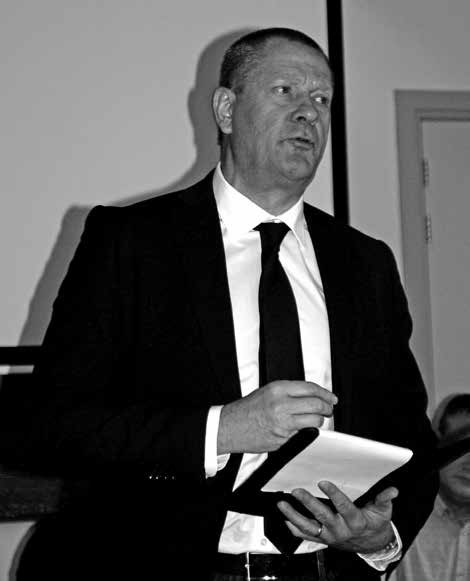
The new chairman Otto van Wiggen outlines his vision for the future of the SFAM at the General Members Meeting. (Photo: Willem Kleijn)
INTERVIEW BEN KOLSTER ON THE OCCASION OF HIS RESIGNATION AS CHAIRMAN
During the special general assembly of members on November 19th, 2016 Ben Kolster officially retired from his position as chairman of the Association Friends of the Airborne Museum. His retirement seemed like a good moment to take a look back at an eventful period in the history of our organisation. Robert Voskuil sat down for am interview with the departing chairman.
Why did you decide to resign as chairman?
I feel that the SFAM has reached a turning point in its history. That’s not only due to a change in our relationship with the Airborne Museum, but also to the passage of time in general. We’ve sadly reached a point where the generation that lived through the Battle of Arnhem – either as a soldier or civilian – is really starting to disappear. As they die off, we lose the witnesses who truly experienced that event. As a result, the commemorations and stories we tell about September 1944 are inevitably going to change and take on a new character in the coming years. Given these developments, I really believe it is also time for our organisation to have a new chairperson. When you are in charge of an association like this one, you really have to be constantly asking yourself what the extra things are that you can bring to the table, and that’s certainly even more true after a period of seventeen years.
My personal conclusion was that it was really time for something new. I was very hopeful that we’d found such a successor in Alex Koning. He was a man that had a great affinity for all things Airborne, was an experienced leader, and above all a great guy. I really thought he’d be the perfect person to improve the awkward relationship that the association currently has with the museum. You’ll surely understand what a great shock it was for both me and the rest of the board when he suddenly passed away at the beginning of January 2017.
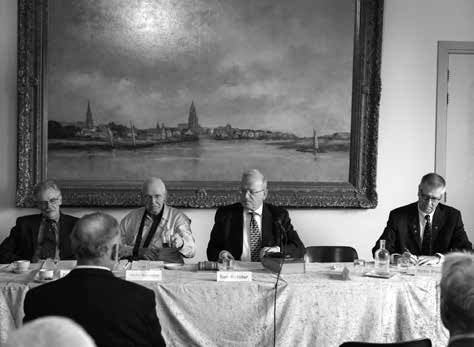
The general assembly of members on November 19th, 2016 was the last time that Ben Kolster as-sumed the role of chairman. (Photo: Arjan Vrieze)
You’ve been chairman since the year 2000. How do you look back on that period?
It has been a very interesting time, in which a great deal has happened. Certainly, the complete renovation of the Airborne Museum itself has been one of the most significant events in that time. It was clear that changes needed to be made so that the story of “The Battle” could continue to be told in an adequate fashion in the decades to come. It was inevitable that concessions would have to be made in order to fit the tastes of a modern audience, but I think it’s unfortunate that some of these changes were quite radical, and in fact seem to me to be in opposition to some of the traditional values that the museum itself still espouses. Aside from that, some of the changes to the museum seem like they were very much based on the fashions of the moment. It seems as if certain trends in the museum world change very quickly. Take for instance the use of dioramas. At the beginning of this century they were considered oldfashioned, but now they’re starting to come back again in an updated form in museum displays across Europe. It shows how things can change! But to return to my time as chairman, I’ll certainly never forget the many opportunities I had to meet with and talk to the men and women who experienced the events of September 1944 firsthand. And of course, most importantly, there was the experience of working with all of the many board members and advisers to the SFAM since 2000. I even managed to convince a few of them to work with me on my radio and television programs. That’s turned out to be a wonderful way that we can share the story of “The Battle” with the rest of the country.
How do you see the future of The Airborne Museum and the VVAM?
As far as the museum is concerned, I hope that the visitor numbers in the coming years will continue to grow and that the museum will remain relevant for a long time to come.
However, I do think that means learning to strike a good balance. On the one hand, you have the modern public, for whom the events surrounding The Battle of Arnhem aren’t completely obvious you must make sure that the museum remains relevant and accessible for them. On the other hand, you must also try not to lose the traditions and history that are irrevocably tied to Hotel Hartenstein and those days in September of 1944. If we can do that, then I think there’s a lovely future in store for the Airborne Museum. I also really hope that we’ll very soon be able to return to a good and productive working relationship between the museum and the Association of Friends. I think that this cooperation, even if it becomes less direct in the future, is only beneficial to the museum. Both the association and museum are important parts of Oosterbeek and the Story of Arnhem. – Robert Voskuil
ALTERED ARRANGEMENTS FOR ENTRANCE TO THE AIRBORNE MUSEUM
The closely felt connection of the SFAM and its membership to the Airborne Museum in Oosterbeek is an important principle for the new board.
Therefore, members of the Society of Friends of the Airborne Museum are encouraged to regularly visit the museum. Free entrance to the museum for SFAM members encourages such visits.
The original entrance agreement was valid to January 1 2018. Unfortunately it has not appeared to be possible to come to a proper new agreement with the board of the museum in the short time that has passed since the General Meeting of December 2nd 2017. That will require more time.
To still allow members free entrance to the museum, the board has decided on the following arrangement. Members will pay for their entry ticket at the museum, but they are encouraged to submit their receipt to the treasurer of the SFAM. He will then reimburse them their entry fees. A simple email with a copy of the receipt and bank information suffices.
Please refer to the colophon for contact details.
Members who possess a Dutch Museum card are strongly encouraged to use this card at the museum. That benefits both the Museum and the Society financially.
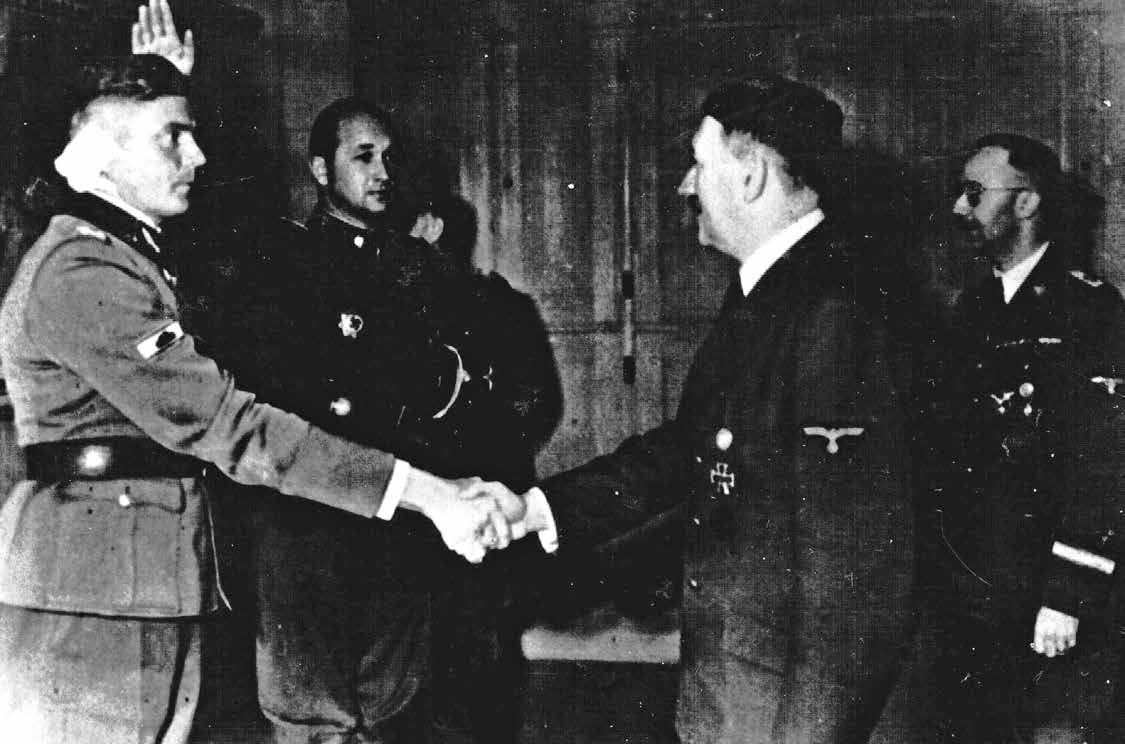
In this photo, taken during Harmel’s visit with Adolf Hitler, one can clearly see that Harmel’s right ear is covered in bandages. During this meeting, he was presented with both the Knight’s Cross and the Iron Cross for his service and valour. (Photo via Wybo Boersma)
HELMET OF SS-BRIGADEFÜHRER AND GENERALMAJOR HEINZ HARMEL
On many occasions in the past, the Airborne Museum was visited by retired Major General Heinz Harmel, the former commander of the 10th SS Panzer division and SSBrigadeführer. After he passed away in 2000, the Association Friends of the Airborne Museum continued to have contact with his son, who also visited the Airborne Museum. Additionally, he has loaned various historical documents to the museum archive so that copies can be made.
Harmel’s helmet has also been offered to the museum as a longterm loan. The only condition is that it must be put on view in one of the exhibits. Harmel wore the helmet during combat in Russia. On the lower edge of the helmet’s right side a hole is clearly visible: this was caused by the impact of a bullet or piece of shrapnel. In March of 1943, SSObersturmbannführer Heinz Harmel’s ear was wounded during fighting near Loswaja and Bereka. Afterwards, he was made commander of the SSInfanterieregiment Deutschland, a part of the Das Reich SS Division. In a photo taken during a visit to Adolf Hitler, in which Harmel was awarded both the Knight’s Cross and Iron Cross, a bandage can be clearly seen on the General’s right ear. During Operation Market Garden, Major General H. Harmel was commander of the 10th SS Panzer Division Frundsberg, which had suffered great losses in Russia and during the action around the Falaise Pocket in France.
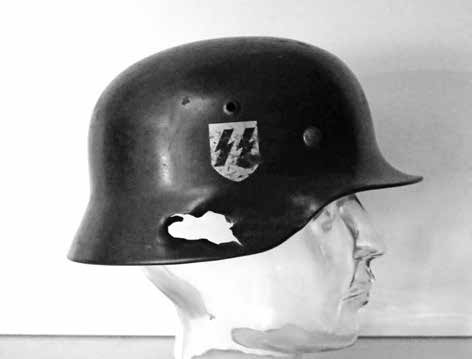
The helmet of Major General Heinz Harmel. In March 1943 SSObersturmbannführer Heinz Harmel received an injury to his ear during combat in Russia. The shrapnel or bulletstrike that caused the injury was also responsible for the hole in the lower righthand edge of the helmet. (Photo Wybo Boersma)
In September of 1994, the division was sent to the countryside near Arnhem to recover, though there would be little time to rest.
Thanks to Operation Market Garden, units from the division soon end up in combat on the DutchBelgian Border, the Rhine Bridge at Arnhem, and the Waal Bridge at Nijmegen.
The helmet is a 1935 model. The SS emblem is visible on the right side; the emblem on the left side was removed during the war. A size 55, it was manufactured by Quist.
If the conditions set forth by General Harmel’s family are met, the board of the Association Friends of the Airborne Museum will present the helmet to the Airborne Museum Hartenstein for longterm loan and display. If acquired by the museum, the helmet will be a unique artefact representing one of the most decorated SS generals of WWII who also played an important role in Operation Market Garden. – Wybo Boersma
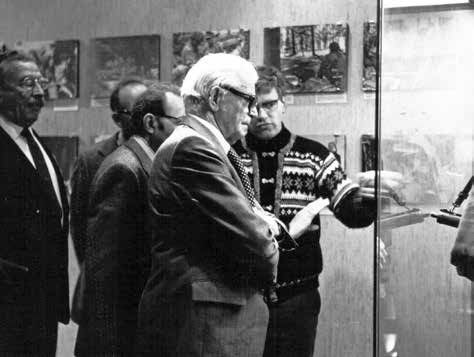
During the 1980s, retired Major General Harmel visited the Airborne Museum on various occasions. Wybo Boersma, dressed here in a rather loud sweater, often guided him around. On the far left of the photo is Ben de Vries, who was the chairman of the Airborne Museum foundation at the time. (Photo via Wybo Boersma)
‘BRITISH EMPIRE MEDAL’ FOR HILTJE VAN ECK
On 17 March 2017 our member Mrs. Hiltje van Eck from Ede was decorated with the ‘British Empire Medal’. She received this high British decoration from the British Ambassador to the Netherlands, Sir Geoffrey Adams, during a spe
cial ceremony at the British residential villa at Plein 1813 in The Hague. Hiltje (75) was raised in a house on the Lunterseweg in Ede. During the war her parents gave shelter to Jewish people in hiding and after the Battle of Arnhem their close neighbours offered a hiding place to Brit-ish Airborne soldiers that tried to evade German captivity. One of these British paratroopers was Major Tony Hibbert, who in October 1944 played an important role in organising the es-cape operation ‘Pegasus I’.
With help of the Dutch Resistance some 138 allied soldiers managed to escape over the riv-er Rhine to the liberated south of the Neth-erlands. After the war some of these British soldiers returned to the Netherlands on a reg-ular basis. A close friendship grew between the Van Eck Family and the veterans. In 1984 Tony Hibbert asked Hiltje van Eck to organise a reunion for all, military and Dutch civilians alike, who had been involved in the Pegasus Operations. This reunion was subsequently re-peated every five years, all of which Hiltje or-ganised. Apart from this, over the last 30 years Hiltje has worked very hard on behalf of the veterans, especially during the annual remem-brances of the Battle of Arnhem.
She still is the Point of Contact for the members of the Arnhem 1944 Veterans Club (this society today is part of the British Parachute Regiment).
As such she is a member of the Airborne Com-memoration Foundation and a board member of the Arnhem 1944 Fellowship.
MIXED FEELINGS FOR THE DEMOLITION OF HOTEL DREIJEROORD
At the end of december 2017 the final sections of the historic Hotel Dreijeroord in Oosterbeek were torn down. At the same time, it was announced that the initiative to save the building had been nominated as one of the candidates for the “Citizen’s initiative of the municipality of Renkum for 2017.” This good and bad news has engendered mixed feelings with the foundation “Preservation World War 2 Heritage Gelderland” which has fought so valiantly to keep this remarkable building safe.
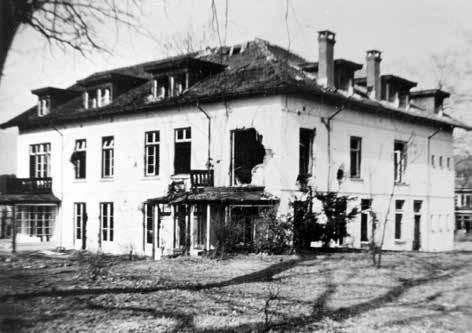
The back of Hotel Dreijeroord, photographed after the Battle of Arnhem in 1945. (Gelders Archief)
After struggling for over a year, a terrain full of broken pieces is all that remains of the building so heavily fought over in those days of September 1944 when British airbornes combated German and Dutch SS units. British veteran Geoff Roberts called the “Second battle for the White House”, according to Wiljo Pas of the aforementioned Foundation. “It strikes a nerve when you speak to someone like that and can sense his emotions about the demolition. Geoff fought around this hotel in september 1944 and we would have been so pleased to preserve this spot out of respect for him and his comrades in arms.” Fortunately the new building will, thanks to the protests, look like the old Hotel, and the nomination has been an encouragement for such initiatives.
82ND US AIRBORNE DIVISION AT NIJMEGEN
On June 23rd 2018 VVAM will organise a battlefield tour in and around Nijmegen. For details see VVAM website and the colophon of this magazine.
During the general VVAM meeting of December 2nd our new president restated the VVAM mission. One of the targets is to study the Battle for Arnhem in the context of operation Market Garden.
This article is to provide background knowledge for that tour. On the day, two big maps will be used, one of which is published here.
This article is mainly based on the book of Norbert A. de Groot Als Sterren van de Hemel.
It is still admirable that Norbert de Groot in an age before the internet was able to gather so much information. To my knowledge there are still no new books that describe the battle for Nijmegen in such an integral way. I am convinced that if such books had been available in English in the late seventies, criticism about the American performance at the battle for Nijmegen would have parallelled such critique about the battle for Arnhem.
Books of the last decade describe mostly actions of one of the regiments, of single battalions, or tell of personal experiences.
The books by Phil Nordyke are especially worth mentioning. • All American, All the Way: a combat history of the 82nd Airborne Division in WW2; • More than courage (504 PIR); • Put us down in Hell (508 PIR); • Four stars of valour (505 PIR) and • An irresistible Force, lieutenant colonel Ben Vandervoort and the 2nd battalion, 505 Parachute Infantry in WW2. • Descending from the clouds van Spencer Wurst.
The last two books provide details about the fighting at the Valkhof. The book Battle for the Bridges by Frank van Lunteren provides new details on German units.
On September 17th, 2017 two new books Pictorial History of the 82nd Airborne Division in the Holland Campaign were presented. This took place at Klein Amerika near Groesbeek. 73 years ago 505th Parachute Infantry Regiment (505 PIR) landed exactly there. Authors: Peter Hendrikx and Michel De Trez, Volume I Burning Bridges, Volume 2 Bridges are Ours (DDay Publishing). In almost 1000 pages, divided over two bigsize volumes, 1600 unique pictures show the actions of the 82nd US Airborne Division.
Publications of the last decade provide a more complete picture of the battle. Over the same period of time, however, the battlefield changed enormously. At Breedeweg many new houses were built, and north of the Waal at Lent complete parts of the battlefield have disappeared into the river.
PREFACE
September 10th 1944 Montgomery convinced general Eisenhower to swing the main effort to Monty’s 21st Army Group. Montgomery ‘s intention was to cross the River Rhine at Arnhem and start an offensive in the direction of the heart of Germany.
Lieutenantgeneral Brereton’s 1st Allied Airborne Army would be involved in operation MARKETGARDEN. Marshall had told Eisenhower to use this Airborne Army with more fantasy.
82ND US ABD MISSION
The staff of Brereton’s 1st Allied Airborne Army was convinced that the earliest possible day to start the operation was September 17th 1944.
In contrary to Sicily en Normandy, the landings should be daylight droppings. Only one lift a day would take place and all three airborne divisions were ordered to capture their targets on the first day.
With that commander’s intent, lieutenantgeneral (Boy) Browning invited the divisional commanders and the commander of the independent Polish Parachute Brigade to Moore Park in London. Browning acted as commander of all allied airborne army’s ground forces.
The Scottish majorgeneral (Roy) Urquhart received the mission with his 1st British Airborne Division to capture the Rhine bridge at Arnhem (or bridges) and hold till a linkup on D+3.
The AllAmerican 82nd Airborne Division of brigadiergeneral James M. Gavin was ordered to capture (and hold) the long bridge over the Maas at Grave, at least one of the bridges over the MaasWaal canal, and subsequently the Waal River bridge at Nijmegen.
The 101st Airborne Division (Screaming Eagles) of majorgeneral Maxwell D. Taylor was responsible for the southern part of the corridor. This division was to capture the bridge at Son over the Wilhelmina canal, the bridge over the Dommel at St. Oedenrode and bridges over the ZuidWilhelmsvaart (canal) and the river Aa at Veghel. At last the 1st Allied Airborne Army had received an imaginative (fantastic) mission.
That same night the staff of the 82nd ABD started to gather information on German units in the area of operations. Of special interest were the German anti aircraft units. Based on their locations the most suitable drop and landing zones would be determined.
General Gavin visited the British Airborne Division. The Brits had recently planned the aborted operation COMET in that same area. The amount of available gliders and transport aircraft determined the available troops on the first day.
Gavin decided to take three of the four Infantry Regiments, a battalion of artillery, Engineers and some antitank guns with command and control elements with him initially.
DROP AND LANDING ZONES
The Drop and Landing zones had to be within reasonable distance of the targets. They had to be accessible for transport aircraft and free of anti aircraft artillery. The landing zones had to be suitable for gliders. The area between Groesbeek (GT0340) and Reichswald (Forest) (GT0536) was suitable for paratroopers and gliders. The terrain near Overasselt (FT9238) was only suitable for paratroopers, at least that was the idea.
At Overasselt 24 Pathfinders with the socalled EUREKA radio beacon landed to guide the airborne armada. Nice to know is that the pathfinders commander, luitenant Jaubert is pictured on the volume “Burning Bridges”. Striking is that he is using a part of a British parachute harnas!
His son attended the book presentation on September 17th 2017. He received the first volume, fitting as the son of the pathfinder who landed among the first of the 82nd ABD at Overasselt.
THE GERMANS
Near Groesbeek and Grave (FT8938) 4 light Flakbatteries were discovered. At Nijmegen there was heavy Flak. Along the MaasWaal canal trenches were spotted. East of Groesbeek was an antitank ditch. Rumours were that the Reichswald was full of Germans, even tanks! Locations of German reserves were unknown.
German units in the 82 ABD area of operation were mainly training battalions.
After watching the landings the German Stadkommandant fled to Germany. A German colonel Henke of the Fallschirm Lehr Stab started organising the defence of Nijmegen at his own initiative.
GAVIN’S CHOICES
After talking to Browning it was clear to Gavin that occupying the dominant Groesbeek heights was more important than trying to capture the Waal bridge on the first day. He decided to initially commit only three of his four infantry regiments. They were transported in 482 dakotas and 50 gliders.
Landing zones north and south of Groesbeek got the codenames DZ TARA, LZ TARA, LZ NAN en DZ NAN. The DZ near Overasselt was called OBOE.
MISSIONS OF THE REGIMENTS
504 PIR. 504 Parachute Infantry Regiment, nicknamed ‘Devils in Baggy Pants’ with its 2000 paratroopers was tasked to capture and hold the bridge at Grave, occupy the area Grave Heumen (FT9638) Hatert (FT9543) and capture and hold at least one bridge over the MaasWaalcanal.
Commander 504 PIR was colonel Tucker. 505 PIR. Colonel Ekman with his ‘Panthers’ was tasked with clearing Groesbeek of enemy, defend the area south of Groesbeek against German counterattcks from the direction of the Reichswald. 2-505 of lcol Vandervoort was divisional reserve. LZ NAN had to be available on D+1 and 2 for subsequent lifts and resupply. 508 PIR. Colonel Lindquist was to defend the area north of Groesbeek. Gavin told Lindquist to send a battalion to the Nijmegen bridge as soon as circumstances were favourable.
THE LANDINGS
After preliminary bombardments the division landed between 1300 and 1400 hours, September 17.
At Grave bridge a Feldwebel was killed. He was in charge of the demolitions. Now a Gefreiter (corporal) was made responsible. Shortly after two lonely Dakotas dropped 24 pathfinders near Overasselt. They had 20 minutes to put up their beacons, panels, and coloured smoke.
At 1302 hrs 505 PIR landed around Groesbeek.
It should only have used DZ NAN but 2505 dropped later due to evasive manoeuvres and landed at the Kamp in DZ TARA.
At 1312 hrs 504 PIR landed near Overasselt and south of the Maas near Velp, 1 km southwest of Grave. 508 PIR landed at 1330 hrs northeast of Groesbeek as planned on DZ TARA.
Around 1330 hrs 307 Engineer Battalion was dropped on Knapheide. Twelve 75mm Pack howitzers of the 376 Field Artillery Battalion were dropped by parachute. This was a first! At 1800 hrs the first shells were fired into the Reichswald as a warning.
Around 1345 hrs Dakotas with Waco gliders appeared. Most of them landed at Knapheide instead of at LZ NAN. Finally, Browning’s headquarters arrived in 35 Horsa gliders. They landed at LZ NAN just north of Breedeweg.
FIGHTING FOR THE OBJECTIVES
505 PIR. This regiment “The Red Devils” landed with two of its battalions at DZ NAN. 2505 landed near the Kamp just north of Groesbeek.
This battalion of lieutenantcolonel Vandervoort was divisional reserve and assembled at 1545 hrs on height 81.1 (Hoge Hoenderberg). 3505 destroyed two FLAK at Ashorst and Lage Horst. The commander, major Kaiser, sent his H en G companies in the direction of Groesbeek.
His third company, I/3-505, was sent in the direction of the Reichswald.
Gavin landed alongside 1-505 of major Talton Long on the Knapheide DZ NAN. 1-505 was ready for action within 30 minutes. Most of them assembled in the Bisselt woods. From there fighting patrols were sent to Grafwegen, Plasmolen and Mook. A patrol near the railway bridge of Mook witnessed it blown up. Around 1500 hrs a defensive line was formed from Kamp, just east of Groesbeek over Breedeweg to St Jansberg. It was here that the Germans reacted first. 504 PIR. At 1315 hrs 504 PIR landed north and south of the Maas. 1-504 of major Harrison landed in the eastern part of DZ Oboe. Major Harrison was tasked to capture at least one bridge over the MaasWaalcanal. A/1504 within 15 minutes was heading for the bridge at Malden (nr. 8). Before their eyes the bridge was blown. C/1-504 headed for bridge nr. 9 at Hatert. After of forced march of 6 kilometres they reached the bridge to see it blown in their faces. B/1504 was more fortunate.
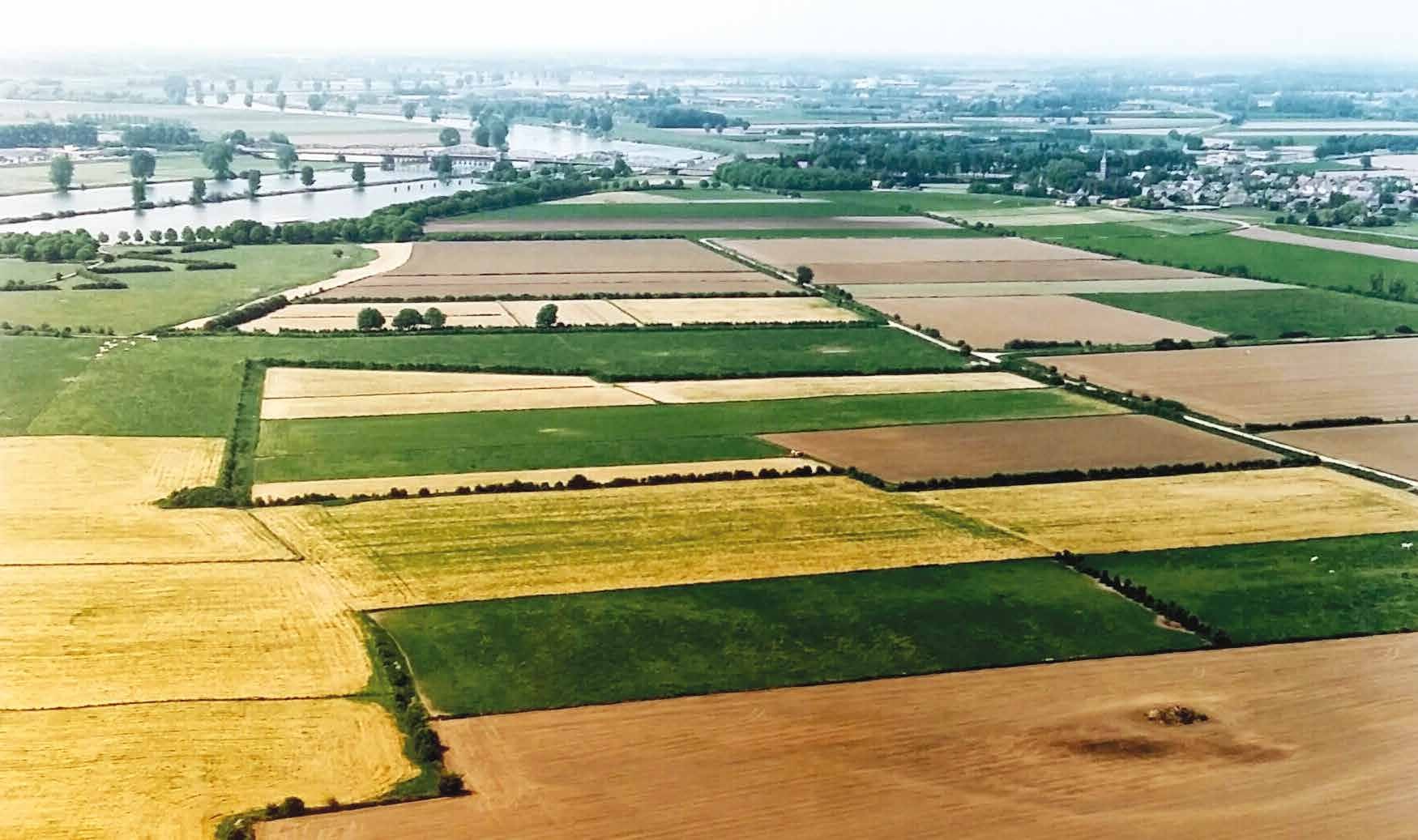
LZ Oboe, with the Maas bridge near Grave visible in the top left portion of the photo.
Captain Thomas Helgeson was able to capture the bridge at Heumen intact after a long fire fight.
Most spectacular was 2504 of major Willems. His mission was to capture and hold the long bridge at Grave. One of Gavin’s rules was that a bridge had to be attacked from two sides simultaneously. For LZ Oboe, with the Maas bridge near Grave visible in the top left portion of the photo.
this the commander of 504 PIR, colonel Tucker, had ordered Ecompany of 2504 of captain Van Poyck to land at the south side of the Maas.
The German defence rested on the Gefreiter.
Upon landing a soldier and a captain of the Intel section headed for the bridge and came back with valuable intel for F/2504. This company attacked the bridge from the direction of the cemetery along the winter dike. F Company came under fire from a 20mm canon on top of a warehouse. There was a prolonged fire fight.
Eleven Dakotas C47 (skytrains) dropped Van Poyck with his E/2504 near Velp. 10 Dakotas dropped the paratroopers a kilometre too far south. Only one aircraft with lieutenant Thompson dropped at the right DZ. It was this group under Thompson that captured the Grave bridge intact. 2504 sent reinforcements over the bridge. Only then major Willems reported: “The bridge is ours”.
3-504 of major Julian Cook (played by Robert Redford in the film “A bridge too far”) landed at 1320 hrs on DZ OBOE near Overasselt. 3504 was regimental reserve and was tasked to expand the bridgehead in northerly direction. For now it was easy in Cook’s sector. 508 PIR. The regiment of colonel Roy Lindquist dropped last at 1328 hrs on DZ TARA north of Groesbeek. 1 and 2508 landed in the hills round Voxhill (GT0343), 3505 at Den Heuvel (GT0442). Around 1500 hrs the battalions were ready and left for Nijmegen. D/2508 was left to defend the DZ. 1508 of lieutenant colonel Shields Warren marched from Groesbeek over the Nijmeegse Baan towards the centre of Nijmegen. This march ended around 1830 hrs near Heilige Landstichting (FT9944). Here was hotel Sionshof. The Dutch resistance reported to captain Bestebreurtje, the Dutch liaison officer to Gavin, that the Waal bridge was only lightly held by the Germans. On this report lieutenantcolonel Shields Warren senta patrol of C/1508 towards the centre. This patrol reached Mariaplein at 0300 hrs but returned around 0800 hrs to the command post.
Around 1800 hrs Gavin realised that Lindquist had not directed a battalion towards the Nijmegen bridge. Gavin ordered Lindquist to send a battalion, but the momentum was gone. 2508 of major Holmes had covered 10 kilometres when at 2030 hrs he reached the line HatertBrakkestein (FT9744). He occupied the St Annastraat, a most important route into the town centre.
Due to failure in communications 508 PIR was not aware that the bridge at Hatert was blown. A patrol of 508 PIR confirmed the bridge blown, but also reported that bridge nr.10 at Honinghutje (FT9345) was still intact. Lindquist ordered major Holmes to capture that bridge (actually a railway and road bridge) that night.
In the meantime at 1400 hrs at Neerpelt in Belgium 13 artillery regiments commenced a bombardment on a 1500m wide front in order to start operation Garden, the advance of 30 Corps. Starting point was Joe’s bridge over the Albert Canal.
THE GERMAN RESPONSE
Within an hour of the allied airborne landings the commander of the II. SS Panzerkorps, general Bittrich reacted by sending the reconnaissance battalion of the 9th SS Panzer Division (Hohenstaufen) to the Waal bridge. The II. SSPanzerkorps by coincidence had its assembly area northeast of Arnhem.
In the meantime at Cleve that Sunday afternoon decisions were taken that resulted in the D+2 counterattacks. The recently retired captain
Schwarz of Wehrkreis IV was made responsible.
Wehrkreis IV had the 406. Landesschütz Division available. This division, however, had a broad front. Captain Schwarz got reinforcements from the Navy Hospital BedburgHau. Remnants of the II. Fallschirmjägerkorps from Cologne were earmarked as reinforcements. German paratroopers of Fallschirm aufklärungsabteilung 12 and the 3rd. Fallschirmjägerdivision boarded trucks and were available the next morning. With this captain Schwarz had 3000 soldiers. The plan was to organise three counterattacks against Mook, Groesbeek and Beek (GT 0246).
THE DEFENCE OF THE OBJECTIVES
The Germans already counterattacked on the evening of September 17th. Around 100 soldiers marched over the road Gennep Mook. They hit a platoon of B/1505 near Riethorst (GT0236). After a heavy firefight the Germans retreated.
The counterattacks on September 18th were more serious. The whole 7000meterwide eastern front was defended by only five companies.
At dawn the Germans attacked. 508 PIR. Beek saw German patrols at noon. American artillery was able to break up the attack.
Between Kamp and Voxhill only D/2508 defended the front. Everywhere the attacks were stopped at the foot of the hills. At Voxhill however the Germans broke through.
This emergency forced Lindquist to desperate measures. 1508 was told to return from Nijmegen in order to clear the landing zones.
As a result the Germans in the town centre could reinforce their defences. G/3508 in the early morning was at 400 meters from the bridge. This company however could advance no more. The 2nd lift arrived four hours late due to fog in England.
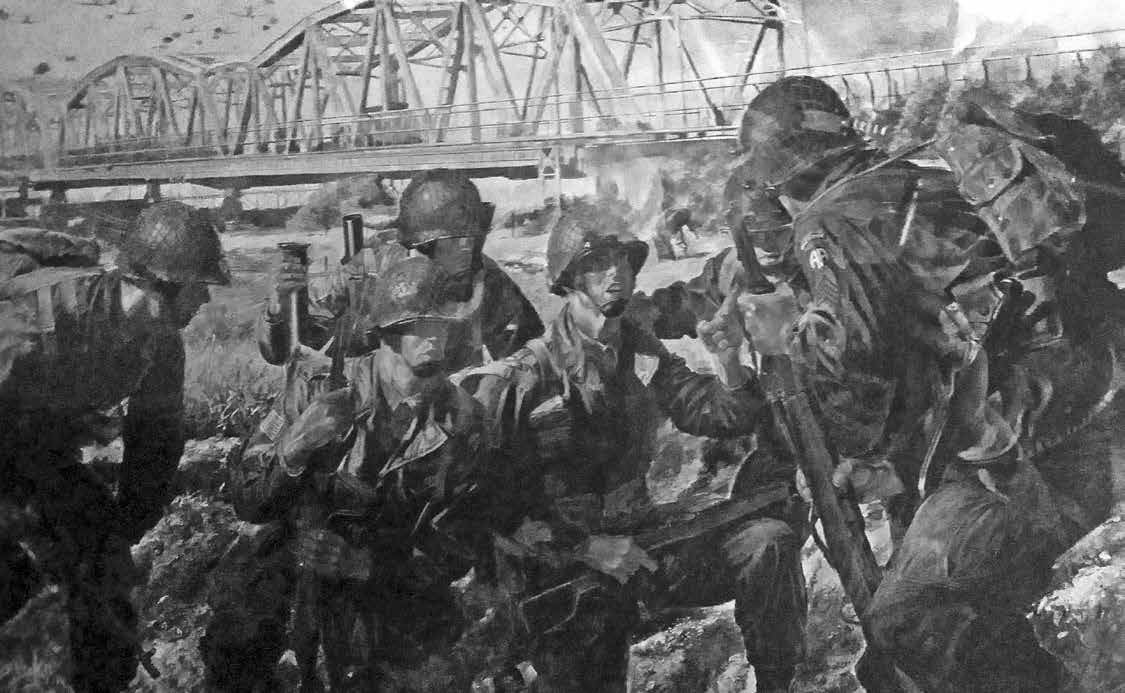
Lt Thompson at the bridge near Grave.
This resulted in more time to clear the drop and landing zones. At 1300 hrs 1508 attacked with C/ and B/1508 followed by A/1508. This attack pushed the Germans back over the Wyler Baan. The Germans lost 50 men and sixteen 20mm guns. 505 PIR. At Breedeweg and Grafwegen the Germans were all over the drop and landing zones.
Here C/1505 (captain Stefanich) supported by a platoon of I/3505 cleared the landing zone.
During the 2nd lift the Germans were able to fire artillery shells from the Reichswald. 450 gliders landed at 1400 hrs on LZ TARA and LZ NAN. 10 minutes after the last gliders 126 B24 bombers (Liberators) arrived over the Knapheide for a resupply.
At Mook the German attack was serious. From Broekpolder (FT9936) the Germans attacked at noon, entered the village heading for the bridge
at Heumen. American paratroopers stopped this attack at the railway underpass.
In the centre of Nijmegen the Germans were in control. With the pressure gone they improved their defences. At the end of the day the Americans left outposts and withdrew to the dominating high ground. It was getting dark. 504 PIR. September 18th was an easy day for colonel Tucker. In the afternoon Gavin proposed a plan to Browning. This plan, which involved 2505 (Vandervoorts divisional reserve) and 3504 (Julian Cook), was to attack the Waal bridge from two sides. Browning judged this plan too risky.
LINK-UP AT GRAVE
September 19th at 0820 hrs the Guards Armored Division made contact with the 82 Airborne Division at Grave
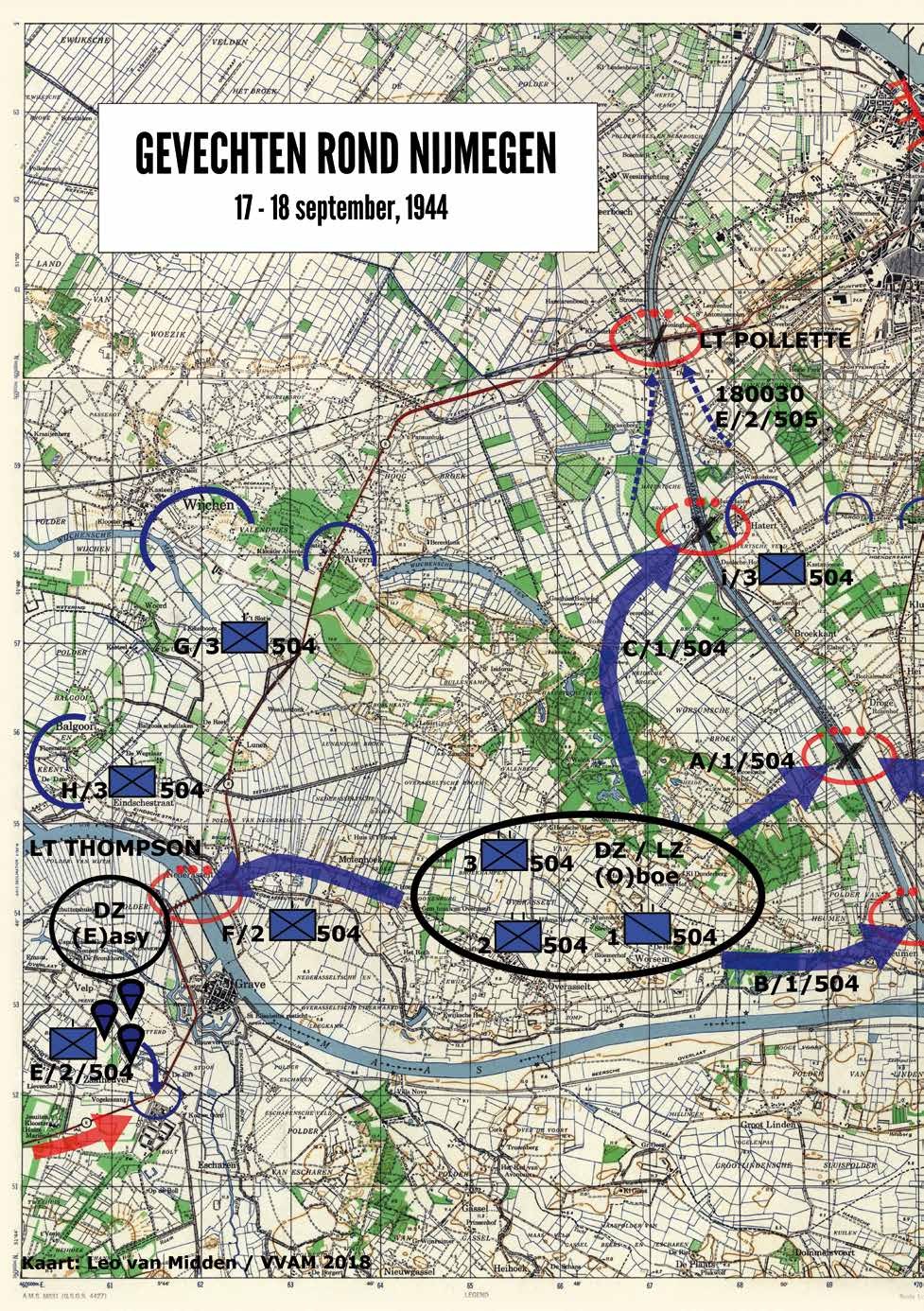
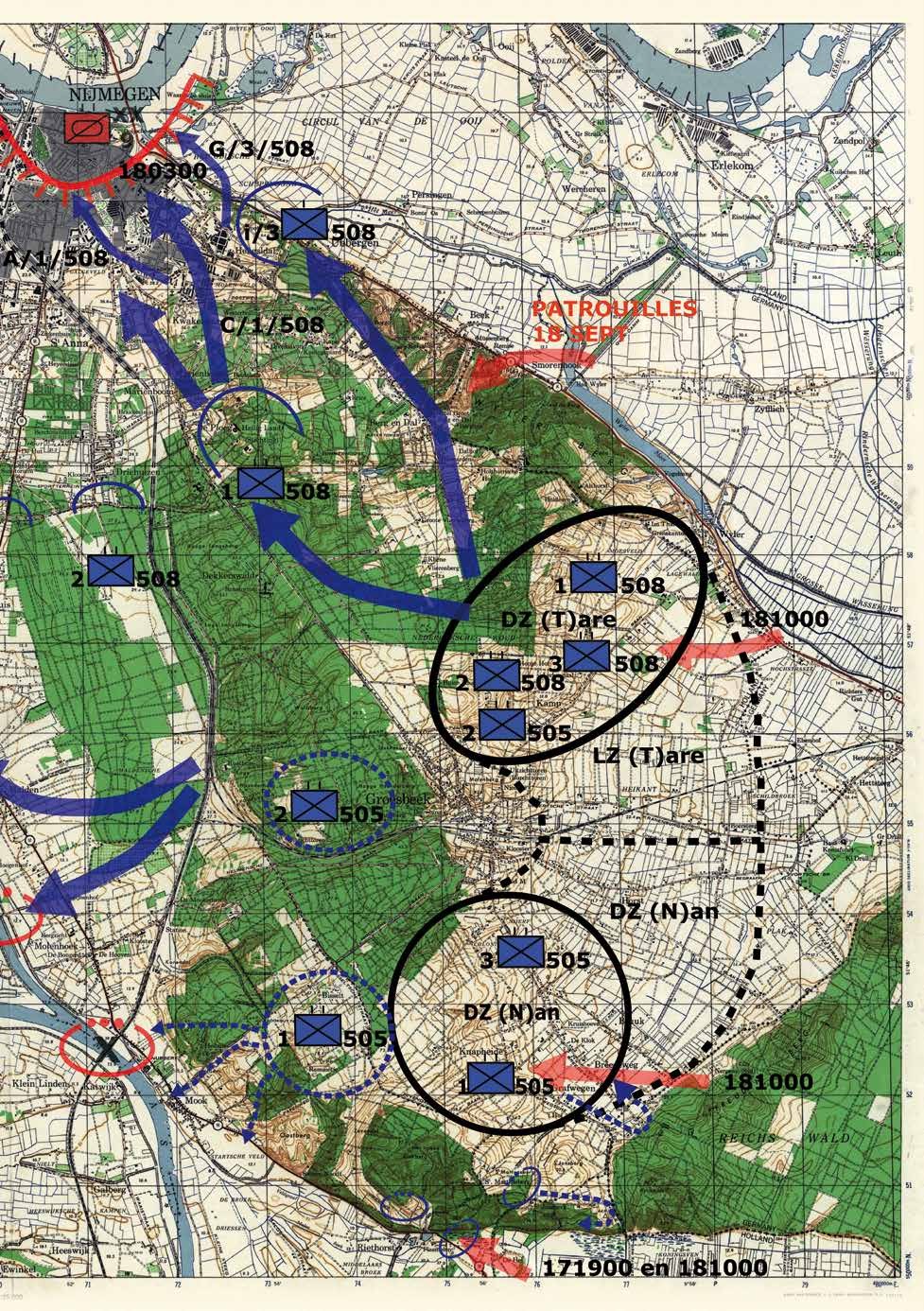
At De Elft paratroopers of Van Poyck’s E/2-504 made contact with the Household Cavalry, a British reconnaissance unit equipped with Humber armoured vehicles and M3 halftracks. The Cavalry drove off to Honinghutje bridge, but the damage to the bridge was considered too much for Sherman tanks. They turned and headed for Heumen and Berg en Dal. There they reinforced lcol Mendez’s 3508.
Gavin and Browning hurried to Overasselt. At 1015 hrs they made contact with 30 Corps. Browning and Gavin agreed in the following plan The Grenadier Guards (tank unit) had to assemble near the monastery Nebo (FT9844). Gavin was to provide the infantry in order to launch a combined attack towards the Nijmegen bridge.
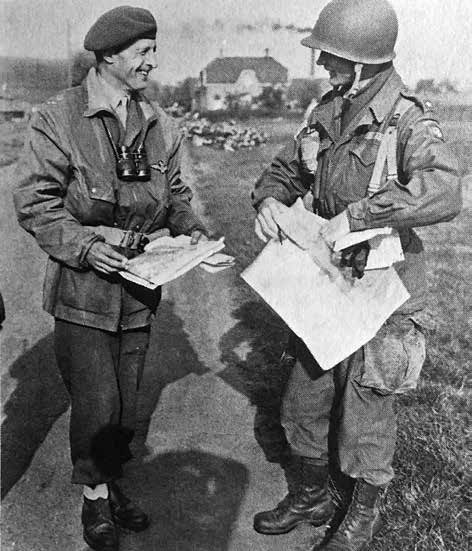
Browning and Gavin wait for 30 Corps, at a point just slightly west of Overasselt
THE CAPTURE OF THE WAAL BRIDGE
Gavin put his divisional reserve under command of the Grenadier Guards. Vandervoorts 2505 headed for Nijmegen. 3504 of major Julian Cook was sent to Jonkerbos (FT9544).
Gavin was looking for an opportunity to attack the railway and road bridge over the Waal from two sides. For the river crossing he had the battalion of the young major Cook in mind. The challenge was to get boats.
That same day (19th) the Grenadier Guards and 2505 launched an attack on the south sides of the bridges. These attacks were stopped late in the evening by Panzergrenadiere. In the defence were 88mm FLAK in an antitank role. The soldiers were from the 10. SSFrundsberg division. These Panzergrenadiere had relieved the reconnaissance unit of 9. SSPzdiv of Gräbner. Hauptsturmführer Gräbner drove back to Arnhem were his unit was destroyed by Frosts 2nd Parachute battalion.
The German defence was known under the name Kampfgruppe Euling (II. Bat PzGrenRgt 21).
After all attacks were countered Gavins plan to cross the Waal with boats became urgent. Horrocks, commander 30 Corps, was in favour and promised to provide the boats.
Wednesday September 20th was the day of the river crossing. After clearing the nearby area 3504 of major Julian Cook with 26 boats near the NYMApower station (FT9549) started crossing the Waal at 1500 hrs.
Tanks of the 2nd battalion Irish Guards, heavy weapons of 2504 and 81mm mortars were firing at the northern bank. The German strongholds in the Valkhof and the Hunnerpark were attacked by tanks and infantry. From the Goffert stadium (FT 9545) British 25pounders fired into the melee.
The How en Itemcompany of 3504 reached the other side of the Waal river. This took place right under the present day powerlines. The river crossing was under continuous fire. Soon the numbers of dead and wounded were mounting. Only half of the boats (13) were able to return in order to get Georgecompany across. After a grim attack some 20mm Flak guns and several spandau machine guns were destroyed by hand grenades. After the arrival of reinforcements the attack was resumed in the direction of the railway bridge. At 1800 hrs the railway bridge was captured. No prisoners were taken. 3504 advanced further towards the road bridge.
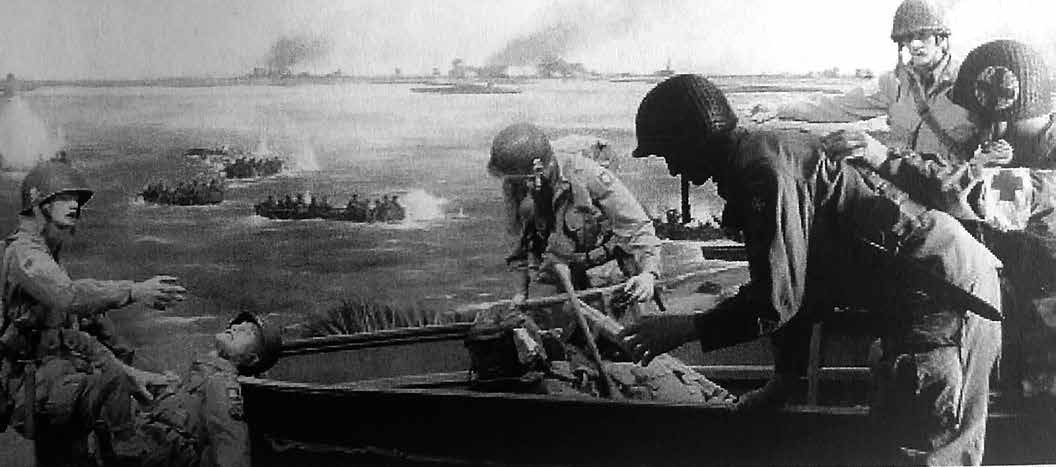
A diorama of the Waal crossing, from the National Liberation Museum 19441945, Groesbeek.
There was fighting in houses and orchards. Around 1930 hrs major Cook with his men captured the northern bridge driveway. 3504 lost 107 men this day. Soon the first Sherman tanks drove over the bridge. That was possible due to the successful attack on the southern parts of the bridges.
The Germans tried to blow the bridge, but somehow the demolition charges did not work.
The bridges over the Waal were captured. The 82nd Airborne Division had accomplished all her tasks. However the hardest fighting was still to come. During the struggle for the Waal bridges three German Kampfgruppen attacked Mook, Groesbeek and Beek. The situation at Mook was so critical that Gavin had to leave the Waalcrossing site and head for Mook. At the Wasserburg Castle in Cleve Field Marshall Model was coordinating the counterattacks in person. The main effort was at Beek. Here Kampfgruppe Becker attacked. Kampfgruppe Herrmann was tasked to attack Malden and Hatert via Mook. Kampfgruppe Greschick attacked north and south of Groesbeek towards the MaasWaalcanal.
The situation at Mook developed into a real crisis. Near Riethorst and Plasmolen American platoons were surrounded by a German battalion of Fallschirmjäger. Another German battalion was stopped near the railway underpass.
After September 20th it was a race to get reinforcements faster than the enemy. Units of 30 Corps did relieve the American paratroopers, but the 82nd Airborne Division had to stay in the area of operations.
The paratroopers jumped with the idea that they were to be relieved after the linkup after 24 hours. The need for infantry however was such that it took till November 10th to relieve 82nd Airborne Division as a whole. Recuperation took place at Mourmelon in France. The rest lasted till December 17th. The division was alerted. This time the division had to block Kampfgruppe Peiper during the Ardennes Offensive.
SS – PARAFERNALIA IN A MUSEUM: DILEMMA?
Every museum is thrilled when individuals donate or offer historical objects on loan, but in the case of SSparaphernalia it calls out the question on how to handle this. After all, there are few organizations so directly associated with nazi crimes as the SS. On the other hand, there is much interest in all kinds of objects that have to do with the SS, which is reflected in the often skyhigh prices collectors pay for SSparaphernalia.
The recent loan of the personal belongings of SS Generalmajor / Brigadeführer Heinz Harmel, 10.SSPanzerDivision ‘Frundsberg’, to the Airborne Museum in Oosterbeek coincided with the exhibition ‘The SS – versatile extremism’ in the National Liberation museum in Groesbeek (which was on show until April 15). This museum states on its website that the image of the SS is romanticized by sensation driven pulpdocumentaries, organizations of former SSwarriors and neoNazis. This makes the topic susceptible for malicious pseudohistory. The Liberation Museum chose to presentan exhibition with a mission: “to prevent misinformation about the most evil organization of the Second World War and to provide a broader, more complete picture of the SS.” A great opportunity therefore to discuss this dilemma with historian Jory Brentjens of the Liberation Museum. “It remains a fraught theme of course, but the idea behind it is that we have noticed that there are a lot of misconceptions about the SS as an organisation in our society. Most people have a very limited vision of the SS. One common association with the acronym is, in first instance, the Aryan soldier, blond with blue eyes, in a black uniform with a skull on it, the ‘creme de la creme’ of the nazi regime that goes to war in the WaffenSS. That only matches with reality for a small part. Or people think of the concentration camps, which in itself is justified, but are often not aware of the fact that these camps were preceded by a whole development history, which was also supervised by the SS: that of the Einsatzgruppen, or the mobile gasvehicles, in fact the whole prelude to the death camps. What we want to show with this exhibition is that the SS was a broad organization, with underlying companies and semiscientific institutes. We want to show that the criminal character of this organization ranges much wider than most people think. This is the core idea behind the exhibition.” An exhibition on the SS — no doubt that provoked a strong response? “We realized very well that such an exhibition would raise many a question and calls for comments. You know that if you’re holding this laden theme, you also will get comments from people who feel that a war museum should be deathly silent about this subject. But by not addressing it, you do not change history. The SS had a major influence on the war, it has done what it’s done.
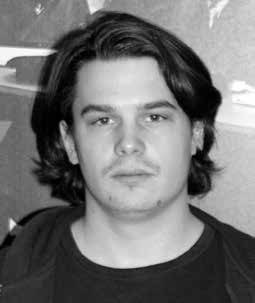
Historian Jory Brentjens of the National Liberation Museum Groesbeek (photo Willem Kleijn)
That you should be able to explain. It is through this dark piece of the history of the war history, that you give a warning. But again, you have to take great care not to mark the SS as this mythical organization it is in the eyes of some: a fanatical elite army, the best of the best. You will get criticism from different angles which produces a curious combination of arguments. We have received comments from rightwing corners that we criminalise the organization and give no attention to the alleged positive aspects of the SS. On the other hand we were criticised by the CIDI (Centre for Information and Documentation Israel) on the press release of the exhibition, which they found too positive. It remains a very sensitive topic, and you must be very precise in choosing your words.
The key is the embedding in your exhibition, and the story that it tells.” When you start displaying personal belongings of a famous or notorious SSsoldier, such as a helmet, a uniform and medals, you put such a figure in fact on a podium. How do you ensure you do not put out the wrong message? “The personal story of general Harmel can be used just fine in principle, but one has to be be careful to choose the correct angle. You should not put the man on stage to show what a fantastic soldier he was. Point is, that the story of Market Garden is not complete if the German reaction is omitted. The 10th SSPanzerdivisie ‘Frundsberg’ was in fact present during Market Garden in Netherlands and did fight against the Allies. In our exhibition, we included a biography of Kurt Meyer, Major General of the 12th SS Panzer Division ‘ Hitler Youth’1. He was the youngest General to the German side during the Second World War. He started his career in the 1st SS Panzer Division ‘Leibstandarte ‘ and fought in Poland, The Netherlands, Greece and Russia. With the 12th SS Panzer Division, he fought his unit almost to annihilation in Normandy. This individual compares well to other generals within the SS like Harmel. Both have been awarded high awards2 and both of them are, with their Division, responsible for, to say the least, questionable actions. About Meyer you could even say that he has been responsible for war crimes. His unit, for example, burned down villages and commited cruelties against civilians oin the the Soviet Union. He was never accused and sentenced for those facts, only because the Allies did not want to extradite him to the Soviets.” “During the preparations for the exhibition a discussion arose over a sentence that I had included in the accompanying text. I had written that he had qualities as general, as commander of the troops. That raised the question of whether this was the story that we want to tell here. We wanted to show that he made sixteen, seventeen yearold boys in his division fight to their death in Normandy. But as far a his personal qualities as General are concerned, we have consciously said this exhibition is not the place and the time to go into that. If you would want to say anything about that, you should explain the matter more extensively, and in this exhibition we simply don’t have the space. So that’s a very conscious choice “. “With General Harmel it might be a bit different, because on the basis of his helmet and distinctions you could explain what his direct role in the

A Knight’s Cross with oak leaves and crossed swords. This version was only awarded 159 times during World War II. A replica like the one shown above only costs a few dollars, while an original is worth at least £25,000… (internet photo)
Battle of Arnhem was; what his choices and considerations were at that time. You have to look closely at how you do incorporate this into the story. In this case you’re talking about embedding it in the MarketGarden story, more specifically in the Arnhem –part. But that’s different from our SSexhibition.
We tried to tell the entire history SS, in which also the Holocaust is included along with all sorts of aspects that are less or not at all familiar.” Does the exhibition explain the Dutch contribution to the WaffenSS? “Yes, in relative and absolute terms, the Dutch contigent volunteers in the WaffenSS with 20,000 to 25,000 men, was is the greatest of all
countries. That we illustrate in the section on the WaffenSS by the story of Gerardus Mooyman, a Dutch volunteer who was the first ‘foreigner’ in the WaffenSS that received the Iron Cross”.
Allegedly Harmel signed the guestbook of the Airborne Museum with the addition “the victor of the ‘Battle of Arnhem”3
“This quote is extremely interesting, if true, it would also tell us something about the man. That information you could use with the display of his helmet and awards showing that after all this time, he still looked upon it that way. No excuses along the line of ‘we fought hard, but realized afterwards that we unfortunately fought for a terrible regime.’ These Germans claimed subsequently not having being aware of atrocities, but so many years after the war, all the facts were well known. At the moment he visited the museum Harmel was well aware about what had happened. It is interesting to see how someone in retrospect does or does not distance himself from what happened.”
– Willem F. Kleijn (accredited Int. GBG Guide / Badge #61)
1 After the war Kurt Meyer was accused, prosecuted and sentenced to death by the Canadians, but that sentence was changed to lifetime inprisonment after German dignitaries protested. In 1954 he was released at the urging of Adenauer. Meyer died on his 51st birthday in 1961.
2 The Knight’s cross with Oak leaves and Swords was awarded only 159 times during WW2. This award was nominated by Hitler personally and granted to soldiers who played a decisive role during a military operation.
3 Assuming that this is true, it is akward that he did not want his name to be associated with the film ‘ A Bridge too far ‘. Hardy Kruger plays Harmel’s the role as ‘Generalmajor Ludwig’
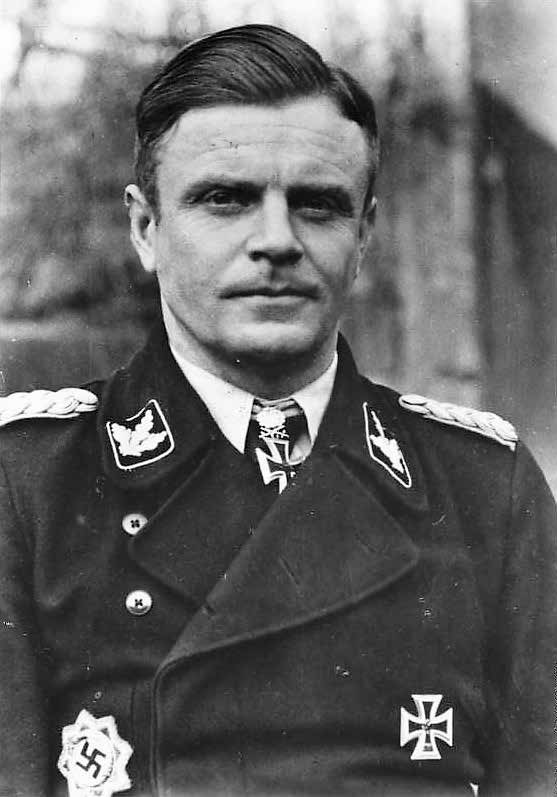
Generalmajor Heinz Harmel, in this photo you can not only see his Knight’s Cross with oak lea-ves and crossed swords, but also the wound he received to his right ear. (photo Bundesarchiv)
MINISTORY NUMBER 126 MEMORIES OF AN EIGHT YEAROLD BOY ABOUT THE ‘BATTLE OF ARNHEM’
We, my parents Berend van Zanten and Cornelia Wilhelmina Zoetekouw, my brother Berend (nickname Ben) and I, lived at 20, Cornelis Koningstraat, at the corner of Johannaweg in Oosterbeek. My parents had a grocery shop there. In September 1944, I was eight years old.
Sunday 17 September 1944 was a day never to forget. It was lovely weather. With my mother, I went to our church, the Dutch Reformed Church on the Benedendorpsweg. Via the Weverstraat, it was roughly a kilometer’s walk from our house.
As usual, we entered the church through the rear entrance, which was on the southern aisle.
Leader on that memorable Sunday, was The Reverend J.G.L. (Jaap) Brouwer. The organist was Henk Meijer, the local shoemaker. The Sexton was Mr Haksteen senior, who also was an undertaker. At the opening of the service, the Vicar, the churchwardens and the deacons arrived in a procession all dressed in sober black. The church service started at 11.00am.
During the church service, unexpectedly, the Germans opened up at British aircraft from an antiaircraft gun, which was sited in the meadow just 50 meters behind the church. A deafening noise which, even so, was quieter than the thunderous noise of exploding bombs. The church shook on its foundations and the chandeliers scarily swung back and forth. I cannot remember if I was afraid, but during the sermon, I desperately needed to go to the toilet. This was located in the vestry, right next to the church entryway. You could reach this vestry via the door next to the pulpit. The outside door of the vestry that morning was open, due to the lovely weather. Curious as I was, I looked outside and just at that moment, an English fighter plane (a Spitfire or Typhoon??) swooped in, flying low and firing at the German ackack site with his machine guns. Thereafter the German firing stopped!
We sang, amongst others, “Our God is a fortress, a haven for refugees” and “What the future brings will be guided by the Lord’s hand”. At the end of the service, we sang with full energy, the first and sixth verses of the “Wilhelmus”, the Dutch National Anthem.
After the church service, we hurried home, via the Weverstraat. Now and again, we had to take shelter from the dangers of the fight going on over our heads. We took refuge, first, in the “Klompenschool” (The Clogs school) – that was a public junior school, where many children wore clogs, hence the name, and in a few other houses.
I still remember exactly which houses, including the house of our GP, Doctor Brevée, between the Weverstraat and the Fangmanweg.
When we got home, Ben sat on our roof to watch the parachutists dropping in the distance. To our utter amazement and surprise, airborne landings had started west of Oosterbeek!
From our street, we watched it all happen. It was an event never seen before. The white parachutes made an enormous impact on us and released powerful
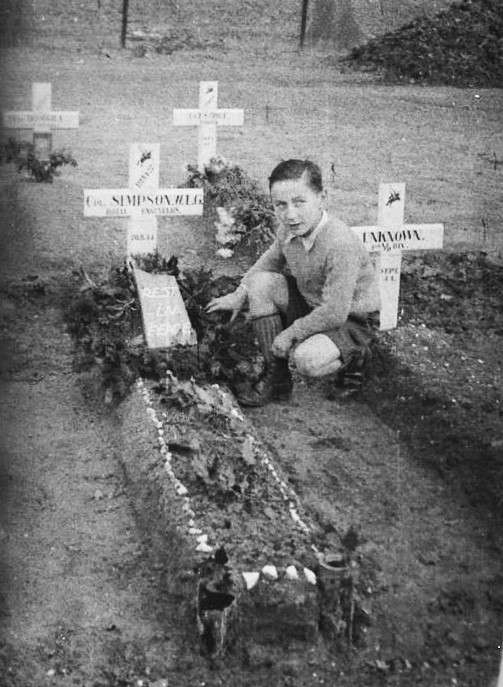
Wim van Zanten at his adopted grave of Corporal William Leslie George Simpson (Joe) at the Airborne Cemetery in Oosterbeek. (Photo from the collection of Wim van Zanten)
emotions. We also saw some aircraft that towed yet more aircraft. It appeared the latter were gliders that landed on the fields near Wolfheze. We thought: Shall we finally be liberated from the damned “Krauts”? The Germans living in the local Association building had suddenly disappeared… Father thought it sensible to spend the night of Sunday to Monday in the air raid shelter. He had built one in our back garden in 1943. It was a long style shelter, about 2.5 meters wide and 4 meters long, with benches along the sides on which the four of us, Father, Mother, Ben and I could sleep. The sides were supported with wooden planks and on the wooden roof, the excavated earth was placed, just under a meter thick. Using the rather steep wooden ladder, made by my Father, you could reach the shelter below ground level. My father had planted tobacco plants in the dirt on the bunker roof.
That night our house was hit by a shell. A section of the roof was damaged, right over my bedroom! I shall never forget that my bookcase, full of books, was thankfully not damaged!
In the morning of Monday 18th September, we found a letter on the counter of the shop, on which the message was: “Aunt Kee, I have taken a bottle of Maggi (soup flavouring sauce) – here is the money”. I do not remember who that was, but it showed the honesty of the local people.
Monday was traditionally ‘Washup Day’. For Grandma Zoetekouw, who lived next door to us, the war changed nothing when it came to such traditions. She took no notice of the heavy shooting and did the washing outside under the leanto, and hung the clean items on the washing line in the back garden, that, partly ran alongside our shelter. In spite of warnings, she hesitated to go indoors saying, “They will never hit me”.
On the Utrechtseweg, on the edge of the path running down hill between the premises of the flower shop Houthuyzen and Villa Maria, stood an enormous beech tree. (to clarify, there is a substantial height difference between the Utrechtseweg and the street running parallel to it, the Cornelis Koningstraat). In the beech, a German sniper had hidden himself, but we knew this. British troops were seeking him but could not get a bead. At the corner of Cornelis Koningstraat and the Weverstraat, a jeep appeared, carrying four British soldiers. They were looking for the German sniper. Ben, who spoke a few words of English, walked up, bending down behind the partly still standing wall that originally protected the whole area, hidden from the German until he reached the soldiers. He pointed out where the sniper was hidden, whereupon the British soldiers followed him along the Cornelis Koningstraat. Then using an old trench, they surrounded the tree and asked the German to surrender. He roared “Nein” and fired with his weapon. As a result, he was shot out of the tree by a British soldier with a spray of fire from an automatic weapon. Dead! We watched as this all took place. The shout of “Nein”, the rifle shot, the noise of the automatic weapon, the breaking off of the tree branches and the falling of the German, I can still hear to this day, if I think about it or if I am telling someone.
In the area surrounding the old trench, during the following days, heavy fighting took place. After the War, in that area, several more soldiers were found buried.
Tuesday 19th September my Father and I went via the Lukassenpad to the Utrechtseweg hoping to see British troops. On the way, I saw dead soldiers. My Father told me not to look, but naturally I still looked and still see the dead English soldier lying with his head on the large boulder which lay at the top of our street, to protect the corner of a workshop. He had tried to look inside the Post Office which lay to the south, down the street. In the Lukassenpad, I saw more dead soldiers. At the corner of the Lukassenpad and the Utrechtseweg, by the cafe of Wiep de Vries and the distribution office, with other interested and happy Oosterbeekers, we met some British troops and some managed to hold a conversation with each other. My Father was given some cigarettes by a soldier. They had taken some Germans as POW’s.
On Wednesday 20th September my brother, wearing his blue overalls and with the badge of the air raid precautions service on his arm, went to Uncle Wim in the Weverstraat, to listen to ’BBC “Radio Orange’’ and also to see if baker Koning had any bread. When he was close to my Uncle’s business, he saw German soldiers and he fled indoors at Uncle Wim’s. Sadly there were Germans there too and Aunt Alie whispered to him “Say that you are
NOTE
After the commemoration of the Battle of Arnhem in 2003 we (my wife Else and I) with others on Monday 22 September, at the Town Hall Square in Oosterbeek, said goodbye to our friend and veteran of the Battle of Arnhem, Harold Padfield and other veterans. One of the veterans was not going with the others to Schiphol.
Tanno Pieterse from the Lest We Forget Foundation, was taking him there. I began a conversation with him before they left. So as always when I chat with British veterans, it centres on September 1944, this time as well.
He asked if I had experienced the Battle of Arnhem, what I did then, where I lived at the time etc. I told him that on 17th September with my mother we were in the Old Church and also explained that our house sat almost 50 metres directly south of where we were
standing. I wanted to tell him the story about the German sniper and said to him “Over there (pointing to the spot where the beech had stood) was a very big beech”, whereupon he interrupted me with the words “with a German sniper”. I stood perplexed and temporarily was speechless. Then I asked him if he could remember the jeep with the four soldiers on board and that someone had gone to them saying he knew where the sniper sat. I told him that the someone was my brother.
He could remember everything, including my story about the “Nein”, the German’s shot and that, after the wave of automatic gunfire, he fell dead out of the tree.
Then he said “I did it, it was my job and I was paid for it”. The veteran who I stood talking to was Bob Laing.
looking for bread”. That apparently was accepted by the Germans. They took him home, with a gun in his back. When my brother came home and told what had happened, he got his bottom kicked by Father and was forbidden to go again or to listen to BBC “Radio Orange”.
When we were staying in the air raid shelter, my Father or my brother regularly went home to get some food. It was only about ten meters walk. Although thus far, the four of us managed to sleep on the benches, suddenly, I cannot remember exactly when, Grandma, Auntie Bet, Uncle Gerrit, Dinie and Bertus, all arrived to share our space, such that we had to sleep sitting up!
In the meantime, the battle moved back and forth. One moment we heard English being spoken and the next moment German. It appeared that the Germans were at the front of our house and the English at the rear and sometimes the other way round. I can still see a German laying behind his machinegun in the scullery of the Marks family home, ready to fire.
During one of these days, a German soldier stood at the entrance to our shelter with his automatic weapon aimed downwards and screamed “Sind hier Tommies?”. My Mother who was not troubled by this, shouted back “Bugger off – there are no English here”. The man responded by shooting a salvo through the tobacco plants and departed.
Thursday 21st September our house was again hit by a shell, now on the rear, as a result of which, Father thought it advisable to move to Uncle Wim’s in the Weverstraat. He thought it would be safer in my uncle’s basement. It cost us about ten minutes to get there and luckily, noone was hurt. I was allowed to take my scooter with us.
My Grandma, Aunt Bet, Uncle Gerrit and the
children stayed put and did not go with us. What Mother took with us were the ration coupons that were already partly stamped, empty wholesalers passes and naturally, the cash takings. I can still see her carrying the bag, in which everything was kept safe. I also remember that, on the roof of the Aarts butcher building, on the corner of the Weverstraat and the Meester Meijers pathway and opposite Uncle Wim’s shop, a green parachute lay, carrying a supply basket.
We weren’t the only ones who thought to find safety at Uncle Wim. As well as Uncle Wim, Aunt Alie, Willy, Judith and Hans, also Mr & Mrs Vreem, Mr & Mrs Köhler with their daughter (Mr Köhler was a poulterer with a business on the Annastraat at the junction with the Weverstraat), Mr & Mrs Roza and the Mother of Aunt Alie with her second husband, Mr Versteegh who all hoped to find a safe hiding place in the basement. I and the other children were made absolutely clear in no uncertain terms that we were forbidden to go outside.
It must have been Saturday 23 September when my Father and my brother went back to our house. They brought the stock of food storage jars to the basement, covered them with carpet and then threw the stock of winter potatoes on top (after the war, the potatoes had all rotted but the storage jars were still OK.) The news got steadily more somber with the passage of time. One day, it must have been 24 September, totally unexpectedly, a deafening noise from cannon fire opened up and then from the barrage of shells. Every time we heard from the direction of the Betuwe the noise of cannon fire, we were scared into silence and if we heard the whistling noise from passing shells, we knew we were safe. Uncle Wim’s building received a direct hit just as my Father was cooking upstairs in the
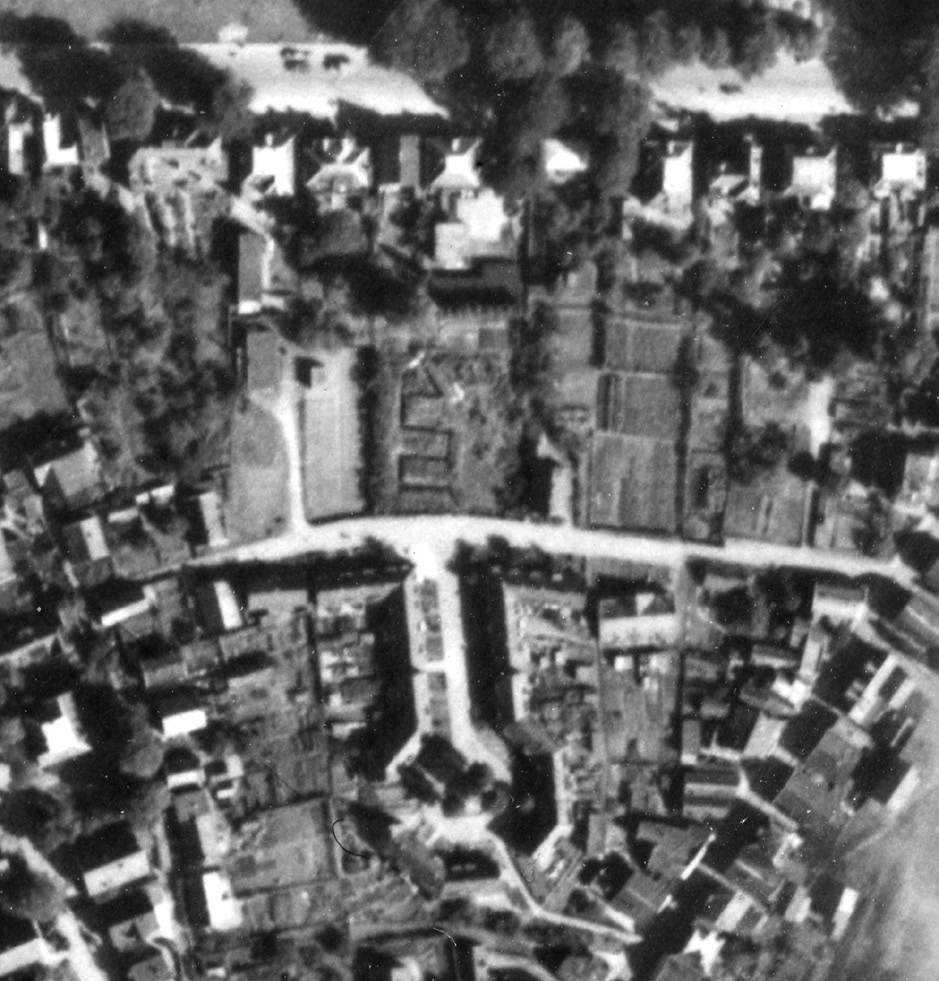
Detail from an aerial photo of Oosterbeek, taken on 6th September 1944 by an RAF photo reconnaissance aircraft. Utrechtseweg runs across the top in the photo and parallel to it, the Cornelis Koningstraat. In the centre of the photo, the Johannaweg runs from the Cornelis Koningstraat in a southerly direction, finishing in a circular culdesac. On the lefthand (western) corner of the Cornelis Koningstraat and the Johannaweg was the house and shop of the Van Zanten family. On the open ground north of the Cornelis Koningstraat, opposite the house, a zigzag shaped trench was dug at the start of the war. It provided shelter in case of strafing from the air. This trench can be seen in the photo as a dark zigzag line. In the lower lefthand corner of the photo, a part of the Lukassenpad and to its left a small piece of the Annastraat can be seen with some difficulty. In the lower righthand corner part of the Weverstraat is visible. (Photo: Royal Air Force, Gelders Archief collection)
kitchen; he always loved cooking. We sat waiting in the basement to enjoy the result of Father’s cooking arts. My Mother screamed after the shell exploded, with her voice made hoarse by her fear: “Berend?”. Through the partly damaged chimney, my Father shouted down “Nothing happened – everything OK with me”.
On Monday 25 September, all the residents of Oosterbeek received an order from the Germans to leave the village. I wanted to take my scooter, but it needed a new valve in the rear tire. Aunt Alie did not agree that a valve could be taken from her hidden new bicycle, so I could not take my scooter with us. Later, the bicycle of my Aunt, my scooter, and the building where they were hidden, were all destroyed by fire.
We left Uncle Wim’s building via the basement in the Zweiersdal, came onto the Vredeberg and walked through the Jacobaweg, the Wilhelminastraat, where we sought cover in the Teesink site, over the Utrechtseweg, over the Schelmseweg and along the railway line UtrechtArnhem to the Mariëndaal gate and via the viaduct under the railway line.
In the lane leading from the Utrechtseweg to the Mariëndaal gate, stood German ackack guns.
We hid under the gateway when the guns began to fire heavily at passing British aircraft. We saw to our horror, how an aircraft was hit, burst into flames and crashed. I saw how the German soldiers congratulated each other! Moving via the Mariëndaal and the Arnhem part of the Schelmseweg, we finally reached the Apeldoornseweg.
On the eastern corner of that junction was a German tent camp. From the older Austrian soldiers based there, we received some bread. Some of them had tears in their eyes.
In a stream of evacuees from Arnhem and Oosterbeek, we walked further towards Apeldoorn. Later that day, we were picked up from the “De Groenendaal” in horse drawn wagons and taken to Apeldoorn. So, for us began the evacuation period that lasted until May 1945. Apeldoorn was liberated on 17 April 1945 by the Canadians. Because we owned a grocers shop, we were allowed to return to Oosterbeek in May 1945. Freek Gerritsen took us home with horse and cart. Entering our village we were shocked at what we saw. Houses and shops were reduced to rubble. Oosterbeek was largely unrecognisable. Everywhere lay piles of rubble, especially on each side of roads, also in our street.
Our house and shop had been plundered and much of the fixtures and fittings had gone. The Christmas decorations had been thrown from the loft and lay in smithereens on the landing. If we went to the bedrooms we walked over the stairwell now open to the sky, a result of the grenade explosion. Therefore, if it rained, we had to use an umbrella indoors. My bedroom was unusable, due to the explosion on 17/18 September. The shop windows lay in smithereens.
The glass Droste advert board had all the paint decoration scratched off, with the intention of using the glass as a window repair. The rest of the shop windows and the shop door were repaired with dark brown planks taken from the trenches.
With planks of differing colours, recovered from here and there, our roof was finally repaired.
The children could not go to school and thus I played every day with my friends in the damaged village. What we all experienced then, is a whole new story!
– Wim van Zanten
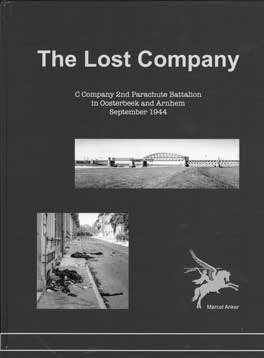
The Lost Company
Written by: Marcel Anker Publisher: Maca Publishing, 2017 ISBN: 9789082571509
Format: 126 pag; ill.; English; Price: € 27.50
Marcel Anker is hardly unknown in our Society. He’s a wellknown expert on the combat along Utrechtseweg on 18 and 19 September 1944. He has also cooperated in a variety of Battlefield Tours. Everything he’s collected over the years has now been published in The Lost Company. It relates the history of C Company, 2 Para down to its smallest details.
After a chapter about the unit’s training and combat actions before September 1944, the author explains the Company’s mission. Its initial task was the capture of the railroad bridge at Oosterbeek. This failed task — the bridge was blown — often gets less attention than it deserves. A clear picture is drawn with the use of maps and photos. Next follows the second mission, the occupation of the Ortskommandantur on Nieuwe Plein in Arnhem. The Company got embroiled in street fighting along Utrechtseweg while trying to perform this mission.
The exact chain of events is explained to the level of the individual using clear maps. Using this book, much of the fighting can be followed on site. The book concludes with the aftermath and some appendices, including the fighting around the socalled Airborne House, Utrechtseweg 72.
This book is certainly worth reading, and it does justice to a company that tried to execute its mission despite strong enemy resistance. – Wybo Boersma
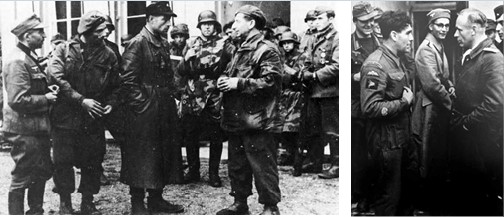
Pictures 1 and 2. On September 24 Quartermaster SergeantMajor Dave Morris (right picture) and Assistant Adjutant & Quartermaster general of the Independent Polish Parachute Brigade lieutenantcolonel Marcin Rotter (left picture) were interrogated in front of probably the same villa by a German officer.
MINISTORY 127: TWO FAMOUS ‘ARNHEM’ PICTURES FINALLY LOCATED
In newsletter 87 from 2002 information was requested concerning two famous Battle of Arnhem photos. The pictures were probably taken at the same location. Given that the two British prisoners and the date of their capture were known, the location must have been somewhere in the eastern part of Oosterbeek.
Quartermaster SergeantMajor Morris describes the scene in the book Arnhem Their Final Battle, page 151): “I was handed to a German officer, who could speak perfect English. He asked me the usual questions, my name, what unit, how many comrades I had left behind, etc. Of course, he only got my army number, rank and name. He did not pursue his questioning. In fact he became quite pleasant. He said: ‘you must feel quite proud to be a Red Devil’ and insisted that I pose with him for a photograph. When in front of the camera he asked me why I did not speak German. I Replied ’Why should I speak German when you can speak English?’ I think he appreciated that, for he patted me on the shoulder and took me inside the house. There I was offered a mug of tea and a piece of bread. I could not believe this was happening!
After about an hour a party of wounded and captured British paratroopers was being marched past the house and I was ordered to join them. When this party reached the St Elisabeth hospital, it was halted and some of the wounded were taken inside.” The rest of the war Dave was a prisoner.
Many a researcher has tried and failed to solve this puzzle. But now, finally, the location is known.
By chance VVAM member Peter Vrolijk found an old picture of villa ‘Heuveloord’ on the north side of Emmastraat in Oosterbeek (picture 3).

Picture 3. Villa Heuveloord at Emmastraat 31 in Oosterbeek. After the war the villa was demolished and a new road, the Beatrixweg, was built here.
Studying the pictures 1 and 2 we notice two big windows left of the main entrance. On the left, there is a construction situated a bit deeper. The details match: the subdivision of the window frames, the profile of the left corner of the main building, the rain pipe left of the main entrance and the arms of the blinds.
The fact that the villa was demolished in 1945/1946 and replaced by newer type buildings and a road contributed to the delay in finding the exact location. Many researchers were looking for the location on the ground in vain in the eastern part of Oosterbeek, but the villa simply no longer exists.
The picture of the villa Heuveloord is printed in part 2 of Blik Omhoog, a series of books (1996) by Cor Janse about wartime Wolfheze (page 779). Many VVAM members will have this series in their bookcase. Because it describes wartime Wolfheze, it is not the most obvious place to look for a picture of a villa in Oosterbeek.
But some people from Wolfheze did shelter in its basement. One of them was even found dead in the garden. The villa was well known, because it used to be the house of the Mayor Van der Moolen from 1919 till 1934. As of 1936 it became a retirement home.
A series of well known pictures were taken of Dave Morris being taken prisoner on September 24. See Magry, Operation Market Garden pages 622623. The surrender scene was also filmed and appeared in the Deutsche Wochenschau newsreel of October 5, 1944. The first frames show Quartermaster SergeantMajor Dave Morris, Private Jimmy Carr and LanceCorporal Harold Cook (all members of 11th Battalion the Parachute Regiment) at the spli of Weverstraat and Dam (picture 4).
Shortly before they had been taken prisoner at the house ‘Vredehof ’ of family de Soet on Beneden(lower part)Weverstraat. Later they were filmed in front of Fangmanweg nr. 35 (picture 5). That house still exists today.
The location Emmastraat fits the route WeverstraatDamFangmanweg to the hospital St Elisabeth’s Gasthuis in Arnhem, see picture 6.
Blik Omhoog, the series of books by Cor Janse mentions the villa several times, but does not reveal the identity of the selfassured German officer talking to Morris and Rotter. Some researchers believed it was the same German in both pictures, but there are doubts about that know. Details of the leather jacket (collar) do not correspond.
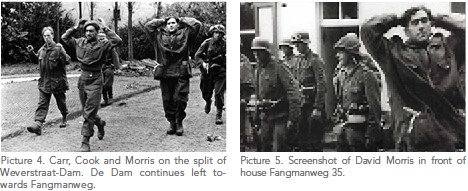
Picture 4. Carr, Cook and Morris on the split of WeverstraatDam. De Dam continues left towards Fangmanweg. Picture 5. Screenshot of David Morris in front of house Fangmanweg 35
Many names as Model, Harmel en Bittrich were suggested in hopes of identifying a prominent German. But a striking detail and common sense point in another direction. The German on picture 1 has a black field hat with white (or silver) piping and a death skull. Without doubt, this is an officer of a Waffen SS Panzer unit. Only members of the Panzer regiment 9 of the 9th Waffen SS Hohenstaufen Panzer Division would have worn that kind of black field hats.
This narrows down the number of possible candidates. There are two officers who fought in Oosterbeek might be candidates: Hauptsturmführer Klaus von Allwörden of the Panzerjägerabteilung of the Hohenstaufen Division (but Panzerjäger were not part of the Panzerregiment) and Obersturmführer A. Harder of the 7th Kompanie of the Waffen SS Panzerregiment 9. Harder was the name giver of the “Kampfgruppe Harder“. Harder is the only Panzer officer of which we know that he fought in Oosterbeek. Kampfgruppe Harder consisted of tank crews without tanks, augmented by other troops.
Known pictures of Von Allwörden do not show similarity with the German officer at villa Heuveloord. Unfortunately, we have no pictures of Harder. His Kampfgruppe fought in the southeastern part of Oosterbeek roughly between Fangmanweg and the river Rhine. So it is very likely by deduction that the German officer on picture 1 could be Obersturmführer Harder.
Then there is the German officer on picture 2.
Janse mentions that the basement of the villa Heuveloord was used by the Germans as a small hospital. Two or three German doctors were working there. And contrary to most Germans it was not unusual for German doctors to speak English. –Paul Meiboom

Picture 6. Part of RAF aerial photograph of March 15, 1945 of Oosterbeek. The trenches are German defensive positions, constructed after Market Garden when the river Rhine became the frontline. 1 = House Vredehof at the split of Fangmanweg/Weverstraat. 2 = Location picture 4. 3 = Location picture 5. 4 = Villa Heuveloord.
VILLA HARTENSTEIN TO BE RESTORED TO ITS ORIGINAL CONDITION
Villa Hartenstein is covered in scaffolding. The building is a nationally protected monument and it is one of the few remaining countryseats in Oosterbeek that was not destroyed during the last year of the Second World War. The history of the building goes far beyond the war however, and in the near future that can be seen as well.
The airs and rich history of Hartenstein as a countryseat will be fully restored with this renovation, with authentic features of the past. As a result of the fierce fighting in 1944, these were partially destroyed and have disappeared. Soon the museum can tell both the history of the Battle of Arnhem and the history
of the countryseat Hartenstein. During the renovation necessary maintenance will also be executed.
Professional painting and repair of (hidden) rotten wood is essential. At the moment, the façade is covered with a layer of rubberbased paint. This prevents the façade from ‘breathing’, which can cause severe damage in the long term. This will have to be replaced entirely, and the underlying plaster restored and repainted in prewar colours.
Finally villa Hartenstein will regain its original ‘attiek’, a raised and partially decorated rooftree, that used to ornament the building. Once complete, the museum will look like its countryseat self again.
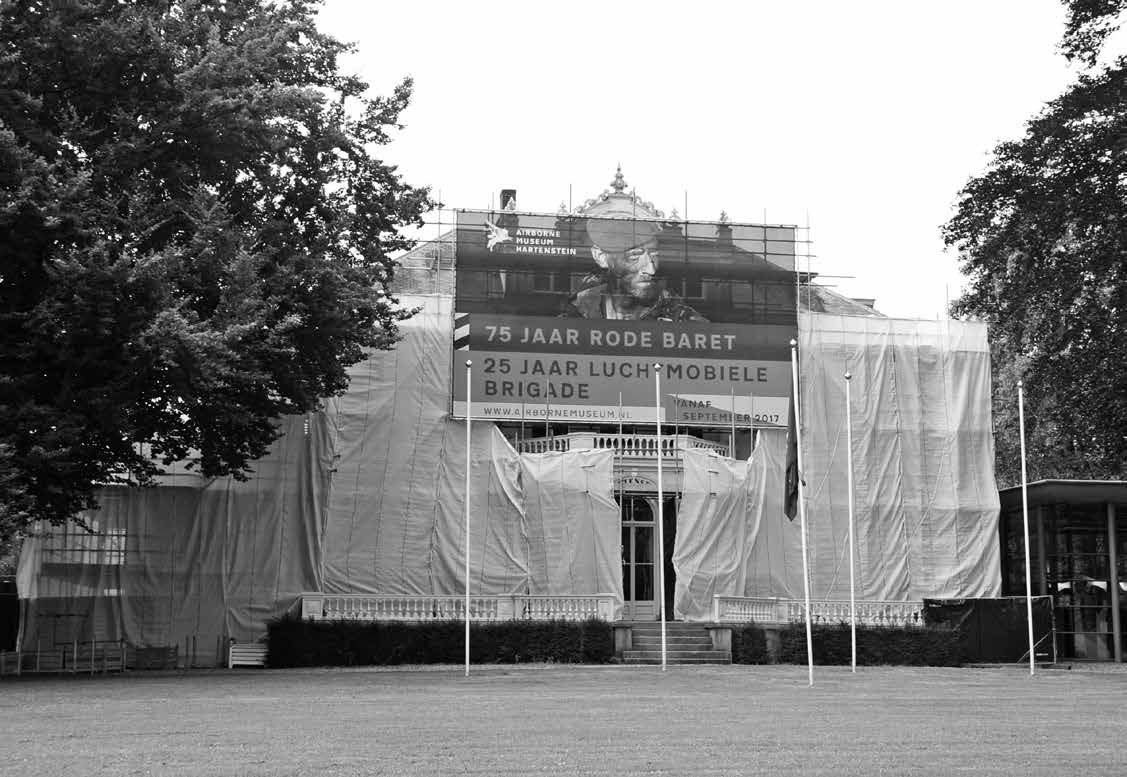
Villa Hartenstein is ‘packed up’ for the restoration currently being carried out on the building’s exterior. A large poster hanging on the front face announces a new exhibtion commemorating the 75 year anniversary of the Dutch Red Berets, and the 25 year anniversary of the Air Mobile Brigade. This exhibit opened on September 1st, 2017. (Photo: Robert Voskuil)
PROGRAMME 2018
17 MARCH
General meeting SFAM
Location: Concertzaal, Rozensteeg 3, Oosterbeek.
Time: 10.30, open to the public at 10.00.
Entry only for members of the Society on proof of membership. Followed by a presentation by Mr. J.Bakker, curator of the Commando Museum.
17 MARCH
Presentation by Mr J Bakker, curator of the Commando Museum, about no 2 (Dutch) Troop, No 10 (Inter Allied) Commando
Location: Concertzaal, Rozensteeg 3, Oosterbeek.
Time: 14.00 – 17.00, open to the public at 13.30.
Entry free for members of the SFAM, for others € 2.50. There is a small exhibit of items around no 2 Dutch Troop from member’s collections.
7 APRIL
Annual book fair for secondhand books and documents related to World War 2
Location: Concertzaal, Rozensteeg 3, Oosterbeek.
Time: 09.30 – 14.30.
Free entry. For more information mail w.boersma@wxs.nl
9 – 13 MAY
Battlefield Tour Normandy.
For more on the planning and general information, see www.vriendenairbornemuseum.nl of get in touch via w.boersma@wxs.nl
23 JUNE
Battlefield Tour Nijmegen.
Campaign of the 82nd US Airborne Division
Start: Talsmalaan, Oosterbeek.
Next to the Airborne Museum.
Time: 09.00 – 17.00.
Entry: Members SFAM € 40.00, others € 45.00.
The tour will be led by Erik Jellema. The price includes bustransport and a lunch.
8 SEPTEMBER
Battlefield tour Arnhem “Nine days of combat near Ede, Oosterbeek and Arnhem.“
Start: Talsmalaan, Oosterbeek.
Next to the Airborne Museum.
Time: 09.00 – 17.00.
Entry: Members SFAM € 40.00, others € 45.00.
The price includes bustransport and a lunch. All participants will receive a guidebook of the tour.
6 OCTOBER
Battlefield tour: “The actions of 1st battalion The Border Regiment.“
Start: Talsmalaan, Oosterbeek.
Next to the Airborne Museum.
Time: 09.00 – 17.00.
Entry: Members VVAM € 40.00; nonmembers € 45.00.
The tour will be led by Erik Jellema. The price includes bustransport in the morning and a lunch.
The afternoon tour will be on foot.
10 NOVEMBER
Airborne Day
Location: Concertzaal, Rozensteeg 3, Oosterbeek.
Time: 10.00 – 15.00.
Entry: €2.50.
Display with explanations of Airborne materials and documents owned by members of the Society. Trade, book fair and other activities are possible. A simple lunch is an optional extra. More information: w.boersma@wxs.nl For any extra information about the activities, applications for participation, and any changes, please check our website at www.vriendenairbornemuseum.nl or send an email to w.boersma@wxs.nl
The Airborne Magazine is a publication of the Society of Friends of the Airborne Museum Oos-terbeek (SFAM) and appears three times per year. The objective is to promote the Airborne Museum, the SFAM and the history of the Battle of Arnhem.
Editors: Jasper Oorthuys Otto van Wiggen
Archiving and distribution of back issue of the magazine: info@vriendenairbornemuseum.nl
Design and lay-out: Christy Beall
Printed by: Wedding Proson, Harderwijk
E-mail adress SFAM: info@vriendenairbornemuseum.nl Phone SFAM: +31(0) 6 510 824 03.
Postal address: SFAM, Wissenkerkepad 22, 6845 BW, Arnhem.
Website:www.vriendenairbornemuseum.nl
Representative in the UK: Niall Cherry, email address: Niall.Cherry@baesystems.com
DOWNLOAD een PDF versie
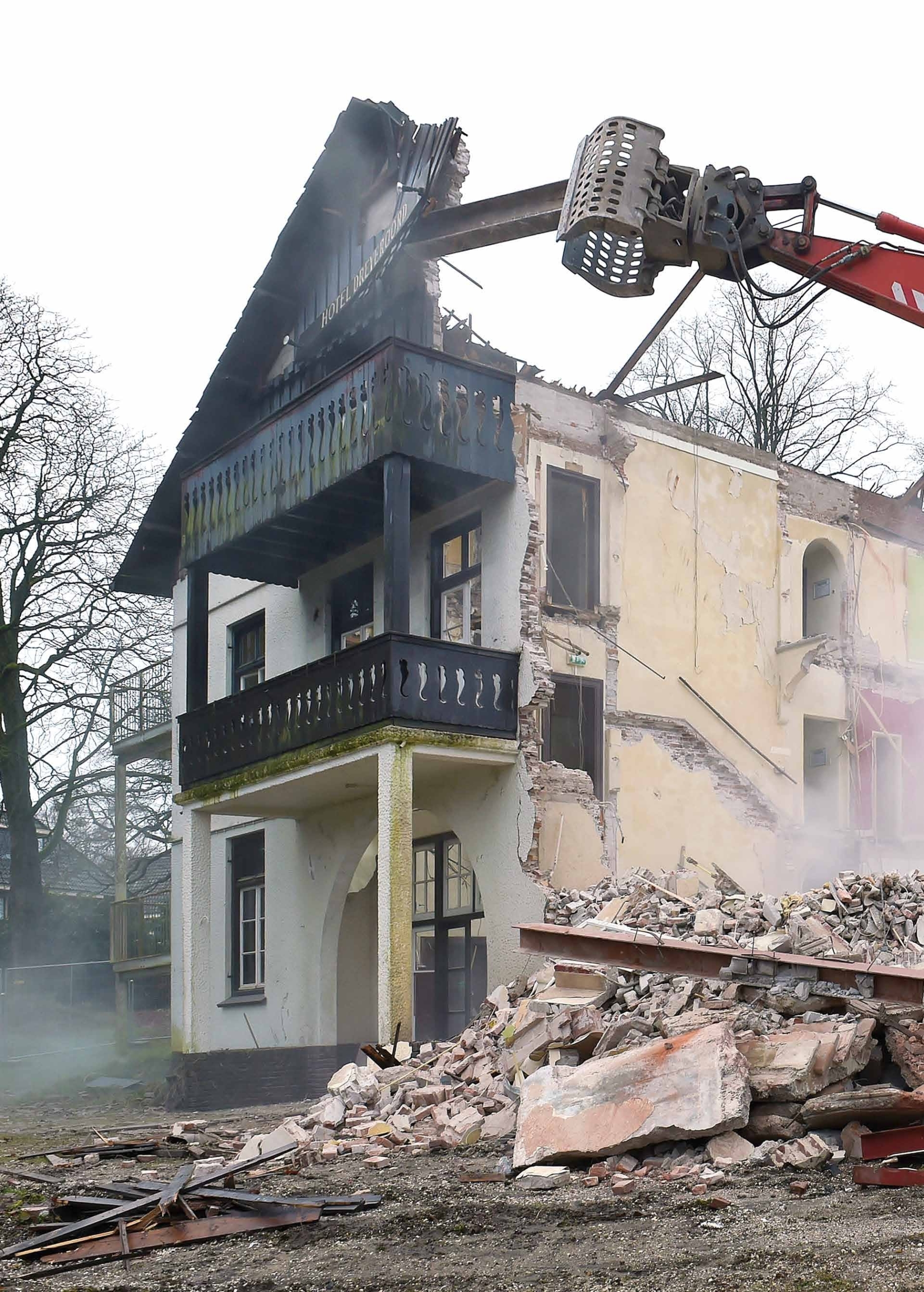
Rear view of Hotel Dreijeroord as it was torn down last Fall. A new building, which will look very similar on the outside as the soldiers of 7 KOSB found it in september 1944, is expected to be completed by the end of this year. (Photo Berry de Reus)
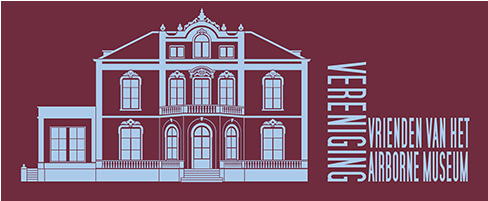

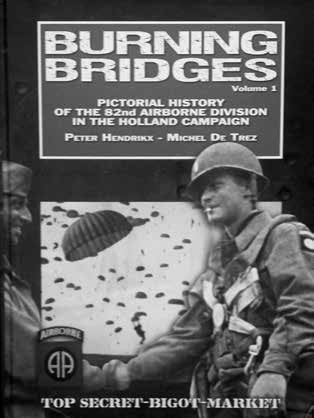
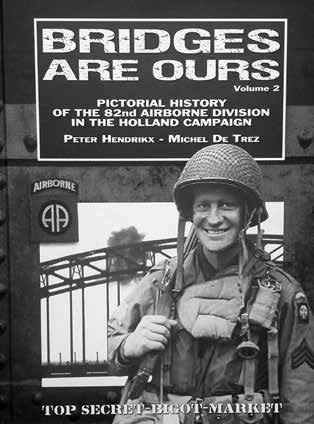
Plaats een Reactie
Vraag of reactie?Laat hier uw reactie achter.